
- Sails & Canvas
- Hull & Structure
- Maintenance
- Sailing Stories
- Sailing Tips
- Boat Reviews
- Book Reviews
- The Dogwatch
Select Page

Crealock 37/Pacific Seacraft 37
Posted by Gregg Nestor | Boat Reviews , Monohull , Reviews
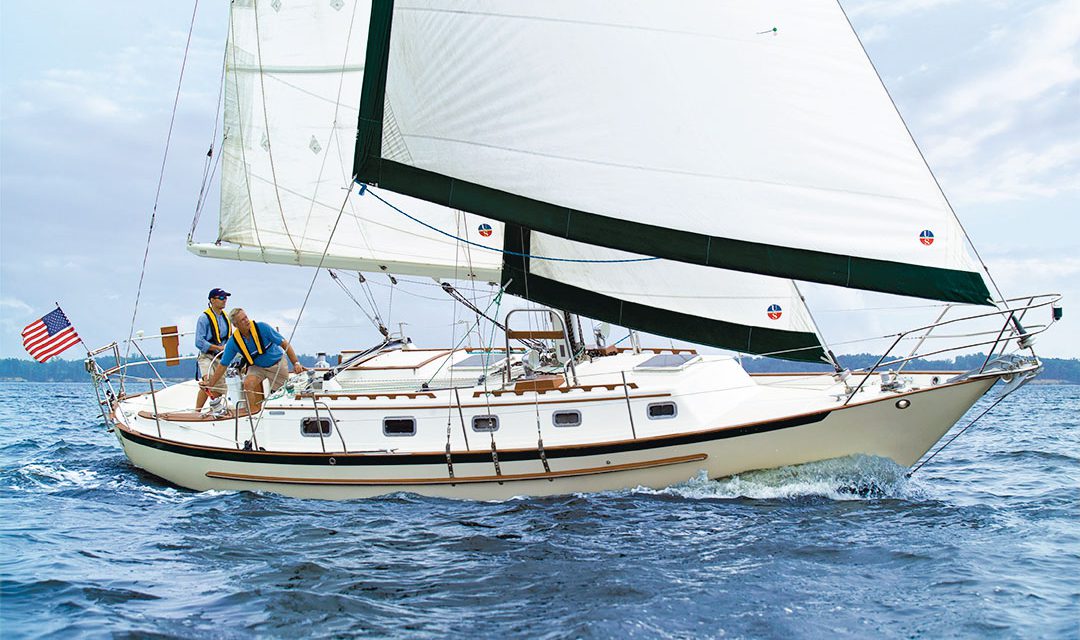
An inspired, tough, seakindly cruiser
I n the mid-1970s, naval architect William “Bill” Ion Belton Crealock entered a sailboat magazine’s boat design contest. Though already a successful designer, he said the contest was, “the only chance I’ve ever had to design a boat that didn’t have to please anyone else but me.”
The 37-footer Bill drew leaned on his bluewater experience gained cruising the Atlantic Ocean in a 40-foot gaff-rigged cutter in his 20s. Aesthetically sophisticated and classically proportioned, it featured modest overhangs, a classic sheer, low freeboard, and an elegant deckhouse.
He paid special attention beneath the waterline, drawing a hull with a large moderate aspect fin keel and a rudder hung on a skeg. Bill honed his boat’s entry for windward performance and gave her an attractive canoe stern that theoretically helps to part a following sea—what designer Robert Perry humorously calls the “Moses Effect.”
“The 37 is an attempt to provide the cruiser with a boat which will travel fast between ports under complete control, and which will yet remind him that the passage itself should be one of the pleasures of the cruise,” Bill said. He didn’t win the contest. “The boat that won was a very modern design for the time, actually a rather hideous boat, I thought. It quickly disappeared.”
At the time, Bill was working with a California company called Clipper Marine, which was producing a series of Crealock-designed trailer-sailers. The company began tooling for Bill’s new 37-foot keelboat, to be called the Crealock 37. Then Clipper Marine went belly-up without building a single hull. With hardly a pause, Cruising Consultants (CC) of Newport Beach, California, acquired the molds and between 1977 and 1979 produced 16 Crealock 37s. Then they went out of business.
Fortunately, Pacific Seacraft ( PS), then in California also, in 1980 purchased the rights and molds. Working with Bill, Pacific Seacraft made some significant changes, and after about 15 years, in the mid-1990s changed the name from Crealock 37 to Pacific Seacraft 37, to be consistent with the names of other boats in their model line. To date, Pacific Seacraft has built several hundred examples.
In 2002, the boat Bill designed for himself was inducted into the American Sailboat Hall of Fame in Newport, Rhode Island, characterized as a boat that has “made boat ownership a love affair” for those lucky enough to sail one.
Martin Nelick and Sally Gardiner-Smith are among the lucky sailors. The couple own hull #7, a Cruising Consultants-built Crealock 37 named Shibumi . Sally and Martin are accomplished singlehanded sailors who have fairly aggressive sailing plans. After selling their respective singlehanding boats, they began searching for that “perfect” cruising boat. For them, their 1977 Crealock 37 is the one.
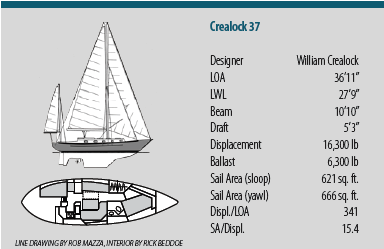
Bill Crealock was born 100 years ago next month and grew up sailing in waters near his home in the United Kingdom. He was educated at Scotland’s Glasgow University, authored several books chronicling his sailing adventures, and produced designs for several successful boatbuilders including Cabo Rico, Westsail, Columbia, and Pacific Seacraft.
The Crealock 37 is traditional with an abundance of character. The cruising fin keel offers quick tacking and responsive handling in tight quarters, and coupled with the generous rudder skeg provides excellent directional stability compared to a narrower fin keel. This configuration also reduces the tendency of the rudder to stall at extreme angles of heel.
The boat has a moderately heavy displacement-to-waterline length ratio of 341, but because its LWL is relatively short for its overall length, the ratio, and boat speed, will increase as the boat heels and the waterline lengthens.
Rod Rowan of Crusader Yacht Sales in Annapolis, Maryland, which has been a Pacific Seacraft dealer since 1986, knows nearly all modifications made to the design through the several changes in ownership, including the company’s move from California to Washington, North Carolina, about a dozen years ago. He says that while the design drafts of the two keels offered were listed as 4 feet 5 inches and 5 feet 6 inches, actual measurements taken on delivered boats were closer to 4 feet 8 inches and 5 feet 10 inches as reflected in the current specifications. (Sailboatdata.com lists the boat’s draft at 5 feet 3 inches.) Rowan adds that the shoal-draft keel is a Scheel keel, designed and patented at one time by Henry Scheel with a shaped bulb at the bottom to improve lift.
Construction
While the Crealock 37 and Pacific Seacraft 37 are essentially the same design, they are not the same boat. Construction of both is conservative and strong, with hulls and decks of hand-laid fiberglass. The hulls are solid, and the decks were sandwich-cored with marine-grade plywood through the mid-1990s. Then builders switched core material to end-grain balsa with plywood inserts at deck hardware. Beginning in the late 1980s, Pacific Seacraft adopted vinylester resin, which is less hydroscopic than polyester, providing better protection against blisters.
The CC hull-to-deck joint incorporates a molded bulwark forming a flanged box that’s sealed with an elastomeric-type compound, through bolted, and then glassed over. Strong and dry, the resulting joint is finished with a 4-inch-wide teak cap rail. Rowan says most current boats are fastened with 1/4 -inch x 20 stainless steel screws, 4 inches on center, plus 3M 5200 adhesive, with no leaks that he’s ever heard reported.
The differences in the two boats is most apparent in the interior. The CC interiors are stick-built, featuring teak-trimmed mahogany ceilings and an oak overhead. The sole is narrow oak planking with ebony polysulfide in the seams. Pacific Seacraft introduced molded fiberglass structural interior modules that retained most of the interior teak joinery while also brightening the spaces considerably. They use a longitudinal and transverse framing system, including mahogany-veneered plywood bulkheads tabbed with fiberglass to the hull and deck. For added stiffness, the main bulkheads are also attached via 5/16 -inch through bolts using an ingenious teak beam system.
The keels of both CC and PS versions are solid-lead castings external to the hull and fastened with stainless steel bolts. Rowan says the original CC keel was scrapped in favor of the two current Scheel and standard keel options. The CC boats feature a Volvo saildrive unit forward of the skeg, whereas the PS boats have an aperture for the propeller.
Over the years, incremental changes were made to the PS boats, such as offering optional chrome-plated bronze portlights and hardware instead of bare bronze, and several different treatments for the inside walls of the coachroof—teak veneer and an off-white Formica. All interior teak was oiled until ’96 or ’97, after which a varnished option became available.
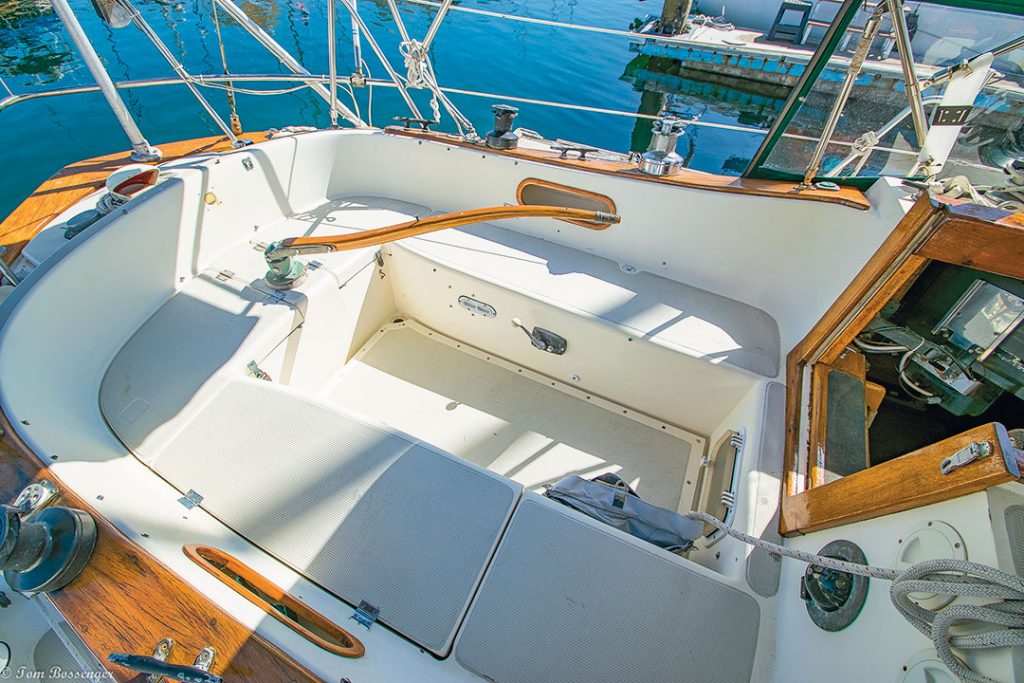
With only 16 Crealock 37s built, there’s scant information as to what was standard and what was optional. It also appears that a few of the final hulls were sold bare and owner-finished. Consequently, most of the CC Crealock 37 information in this review is based on what I found aboard Shibumi .
The cabintop is a bit cluttered. Notable features include a pair of 19 x 19-inch teak-trimmed bronze hatches, one over the V-berth and the other over the saloon. Four Dorade vents provide additional ventilation into the head, saloon, galley, and navigation station. Also on the cabintop, just forward of the sea hood and mainsheet traveler, are a pair of 39-inch-long tracks and cars to handle the staysail sheets.
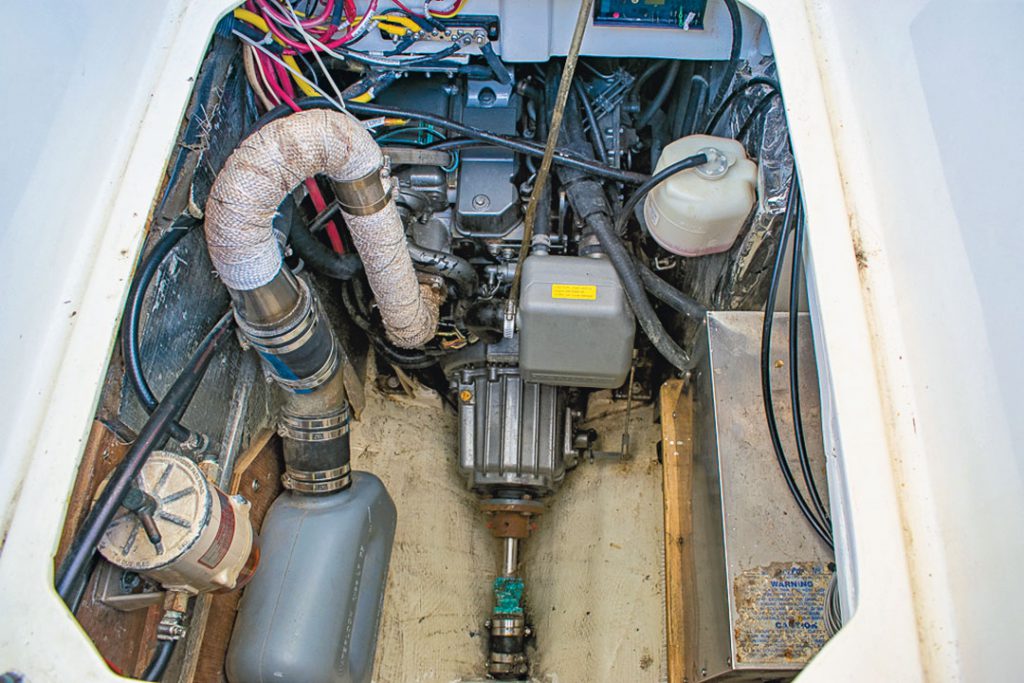
On the PS-built boats, engine access via the cockpit floor was modified and made smaller, about 2 x 2 feet.
The surprisingly roomy forward cabin is home to a V-berth that measures just over 7 feet 6 inches long at its head and narrows to 3 feet at its foot. On PS boats it’s offset to starboard. Besides an unusual overhead drawer, stowage for larger, bulkier items is available beneath the berth. Also beneath the V-berth is a 40-gallon aluminum potable water tank (an additional 60-gallon fiberglass tank is beneath the saloon sole).

Aft and to port of the V-berth is a hanging locker with bureau top. Three opening portlights and the overhead hatch provide this compartment with excellent illumination and ventilation.
Access to the head is directly across from the hanging locker. On Shibumi , the owners replaced the original marine toilet with an Air Head composting toilet in part to eliminate the need for a holding tank. In addition to hot-and-cold pressurized potable water, there’s also a saltwater hand pump. A solid mahogany door swings to close off the head as well as add privacy and a small changing area to the forward cabin.

The saloon is well ventilated with one opening portlight, two large fixed portlights, a single Dorade vent, and an overhead hatch. A pair of overhead grabrails makes for safe fore-and-aft maneuvering. Headroom is over 6 feet.
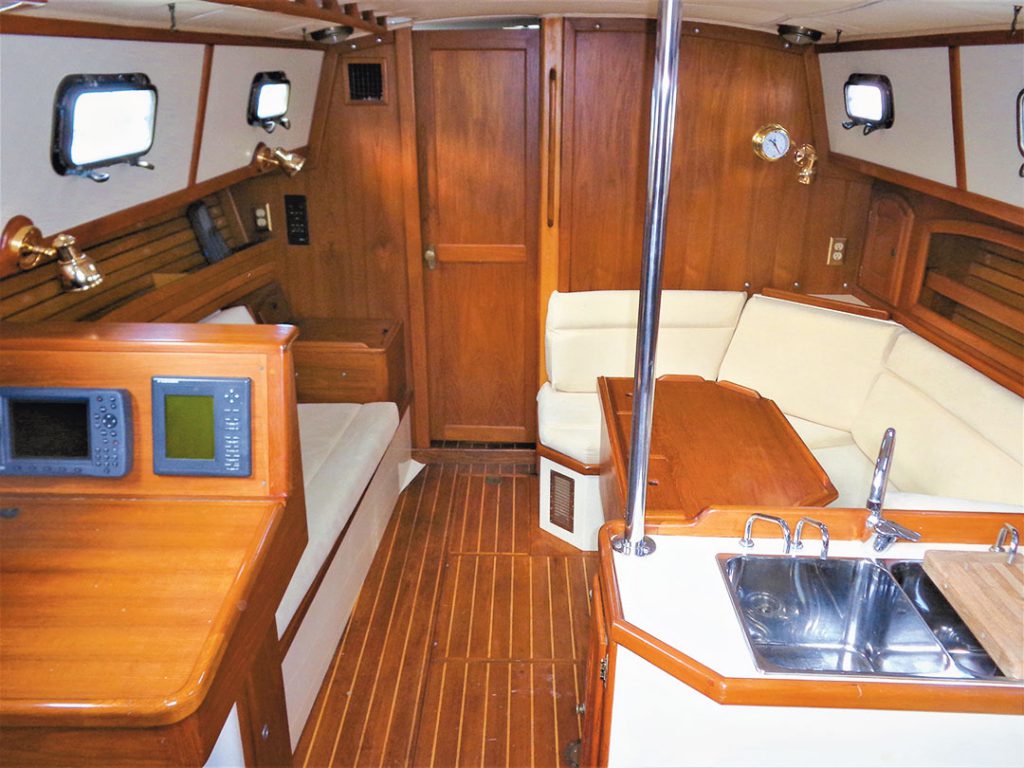
The L-shaped galley is immediately aft of the starboard settee. A series of drawers, a half-dozen cane-fronted lockers, and a clever dish stowage unit provide storage.
Shibumi is a yawl with double headsails. All spars are aluminum extrusions painted white with polyurethane. The mainmast and the mizzen are deck-stepped. Aluminum compression posts below support both; the mainmast post is incorporated into the main bulkhead, which in turn is glassed and bolted into place.
Mainmast rigging is a single set of spreaders, forestay, split backstay, a pair of cap shrouds, and double lower shrouds. Rigged with a staysail, Shibumi also has a pair of running backstays. The mizzenmast is supported by cap shrouds, intermediates, and lowers.
All standing rigging is stainless steel wire with bronze turnbuckles (stainless steel on PS boats). The stainless steel chainplates are outboard and bolted to the hull. When in port, the main boom rests on boom gallows. Both main and mizzen are sheeted mid-boom, the main to a traveler on the coachroof and the mizzen to a traveler mounted on the stern pulpit.
Headsail sheets lead aft through cars and tracks mounted on the caprails. These sheets terminate at Lewmar 27 self-tailing winches mounted on the cockpit coamings. Aft on the coachroof is a pair of Lewmar 10s to handle the staysail sheets and a #18 to service the mainsheet.
Initially, PS offered the 37 as a sloop, cutter, and yawl, though the latter was seldom ordered, and today most are sold as cutters and some sloops.
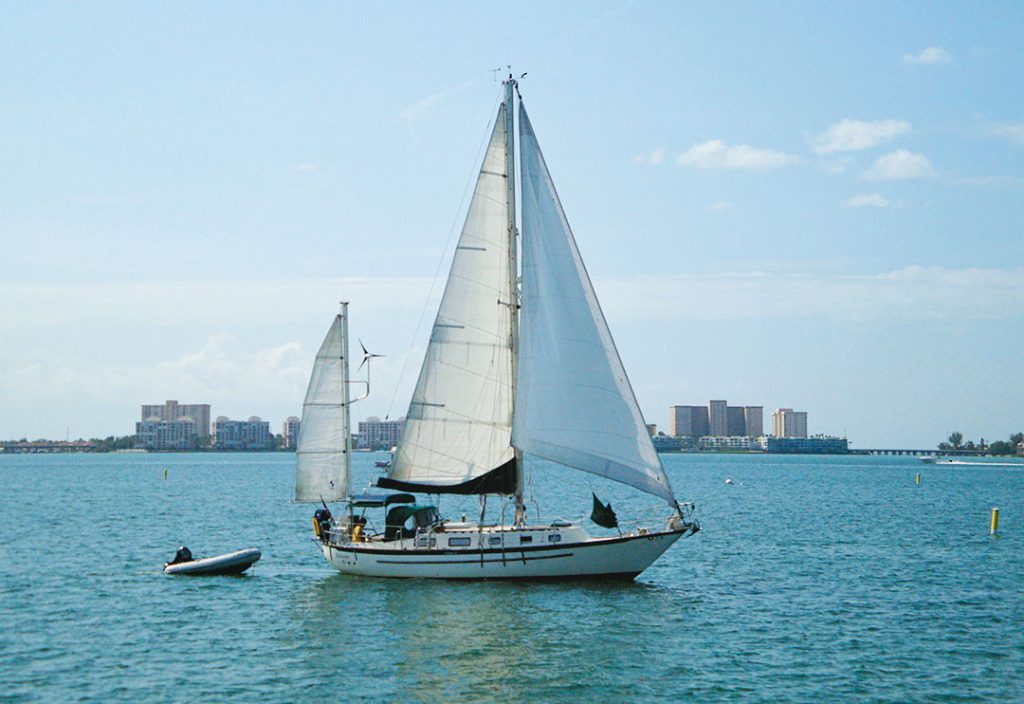
With a long sailing history and an excellent reputation for handling heavy weather, the Crealock 37 and Pacific Seacraft 37 are well balanced and easily managed by a short-handed crew.
With a bit of wind, the boat heels quickly to around 15 degrees. Once there, it’s rock solid. Rolling in the headsail a bit before tacking precludes it from hanging up on the staysail. With fairly quick acceleration and a responsive helm, the boat’s best point of sail appears to be a broad or beam reach.
While the boat is a bit narrow and heels early (less form stability, excellent ultimate stability), its seakindly nature makes long passages comfortable. The split rig adds versatility and easily adapts to self-steering. Under the right conditions and properly trimmed, the boat can eat up the miles. Over the years in the Singlehanded Transpac Race, two Crealock 37s, Coaster and Intrepid , have recorded corrected times that put them among the fastest 10 percent of all finishers.
Conclusions
This design is a Hall of Fame beauty. The boat is strongly built, well rigged, and has a documented reputation for sailing comfortably and fast. It has an abundance of stowage and is a good choice for a small crew. While a new 2020 Pacific Seacraft 37 will cost nearly $500,000, many clean examples from the 1980s and 1990s are available in a range of five-digit asking prices.
Gregg Nestor is a contributing editor with Good Old Boat . He has authored four books on sailing: Twenty Affordable Sailboats to Take You Anywhere, Twenty Comfortable Sailboats to Take You Cruising, The Trailer Sailer Owner’s Manual, and All Hands on Deck . He became a snowbird a few years back, after relocating his boat from the Great Lakes to Florida.
Comments from an owner of the CC-built Crealock 37
The Cruising Consultants version has larger windows, more light, and a nice, wide V-berth. Also, the yawl rig and external chainplates give it a swashbuckling appeal. The entire cockpit sole comes out for great engine access. Our 1978 Crealock 37 was converted from saildrive to direct drive, a plus I think. There is plenty of room in the cockpit as the tiller folds up; and, as there is no sub-cockpit steering binnacle apparatus, space remains below for water heater and watermaker. The lead keel is a major plus. It has a battle-ax stainless steel double bow roller.
Panels rather than vinyl in the ceiling make it easy to run wire and add LED lighting—a major improvement. A large propane locker fits three 5-gallon tanks. The deck glass is thick so it does not perceptibly flex even when coring was removed during repair. No major leaks.
It ghosts along in a light breeze but performs in 12-22 knots. With a 12- to 14-knot breeze on the beam I have put the tiller down and it tracks on its own. The mizzen staysail is a fun and easy sail that really does move the boat under the right conditions. When it gets to 28-30, I can put up just a working jib on the Solent stay and mizzen, and it moves along nicely under control.
The Dorade vent holes were not sealed—so I had to dig out soaked balsa, dry, and repair. The aluminum backing plates for the pulpit bars were corroding and compressing, so I replaced with G10. Original backing plates for the traveler were pieces of thick leather—replaced with G10. The gooseneck was secured to mast by one 3/8-inch bolt that had worked and loosened and been re-tapped repeatedly over the years. The fixed table takes up too much space, so I will be building a fold-away.
—Tim Lamarre, San Francisco, California
Comments from owners of the Pacific Seacraft-built Crealock 37
This 1989 boat sails nicely in light winds, but as I have aged I find myself motor sailing if I can’t get at least 4 knots of speed on wind alone. This is a relatively narrow boat so sails can really be pulled in and sailed close to the wind. You are almost always going to have a heeling motion, and it sails best that way. It sails confidently in rougher weather, is easily reefed, and handles waves better than most boats. Some say it hobbyhorses more than other cruisers, but I don’t think it does. With its canoe stern you can sure tell the difference sailing with the wind behind you; it is so easy to control, and the waves don’t grab the stern and push it around so much.
—Tom Eisele, Hilton Head Island, South Carolina
After a 2019 passage aboard a 1993 model from Bodega Bay, California, to Brisbane, Australia, I can comment about these things: With a crew of two or singlehanding, she is in her groove at 12-25 knots wind speed. Above 25 knots, when singlehanding, I have wished that I had a third reef available for the mainsail. During the harshest of weather systems, while using the trysail as the main and the staysail as the storm jib, the 37 sailed rock solid and on course through the tossed seas, allowing me to get rest below.
—Mark Tolbert, Redwood Valley, California
About The Author
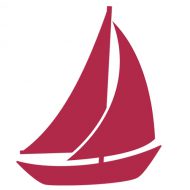
Gregg Nestor
Gregg Nestor is a contributing editor with Good Old Boat. He has authored four books on sailing: Twenty Affordable Sailboats to Take You Anywhere, Twenty Comfortable Sailboats to Take You Cruising, The Trailer Sailer Owner's Manual, and All Hands on Deck. He became a snowbird a few years back, after relocating his boat from the Great Lakes to Florida.
Related Posts

Nigel Calder’s Cruising Handbook: Book review
September 1, 2001
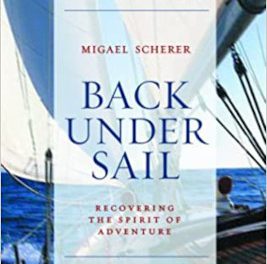
Back Under Sail: Recovering the Spirit of Adventure
October 1, 2003
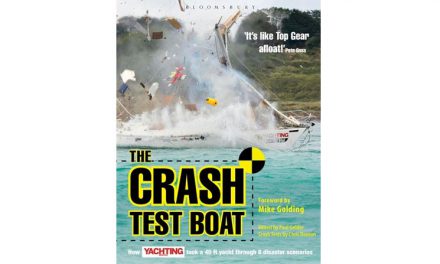
The Crash Test Boat: Book Review
August 1, 2013
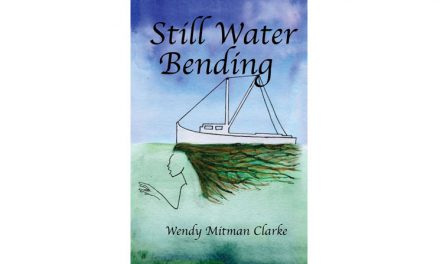
Still Water Bending
December 1, 2017
Current Edition
Join Our Mailing List
Get the best sailing news, boat project how-tos and more delivered to your inbox.
You have Successfully Subscribed!
- New Sailboats
- Sailboats 21-30ft
- Sailboats 31-35ft
- Sailboats 36-40ft
- Sailboats Over 40ft
- Sailboats Under 21feet
- used_sailboats
- Apps and Computer Programs
- Communications
- Fishfinders
- Handheld Electronics
- Plotters MFDS Rradar
- Wind, Speed & Depth Instruments
- Anchoring Mooring
- Running Rigging
- Sails Canvas
- Standing Rigging
- Diesel Engines
- Off Grid Energy
- Cleaning Waxing
- DIY Projects
- Repair, Tools & Materials
- Spare Parts
- Tools & Gadgets
- Cabin Comfort
- Ventilation
- Footwear Apparel
- Foul Weather Gear
- Mailport & PS Advisor
- Inside Practical Sailor Blog
- Activate My Web Access
- Reset Password
- Customer Service

- Free Newsletter

Maine Cat 41

CS 30 Used Boat Review
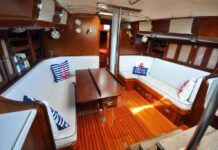
Hinckley 49 Used Boat Review
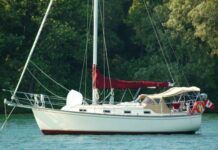
Island Packet 31 Used Boat Review

Best Crimpers and Strippers for Fixing Marine Electrical Connectors

Thinking Through a Solar Power Installation

How Does the Gulf Stream Influence our Weather?

Can You Run a Marine Air-Conditioner on Battery Power?

Master the Sailing Basics: Never Stop Learning the Little Things

How to Mount Your Camera on Deck: Record Your Adventures with…

Un-Stepping the Mast for America’s Great Loop

Headsails and Spinnakers: How to Explain Their Functions to a Beginner

Sinking? Check Your Stuffing Box

The Rain Catcher’s Guide

How to Change Your Engine Mounts
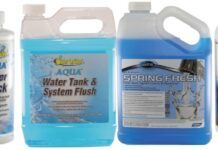
Keeping Water Clean and Fresh

Vinyl Boat Lettering DIY Application and Repair

Those Extras you Don’t Need But Love to Have

Three-Model BBQ Test

Alcohol Stoves— Swan Song or Rebirth?
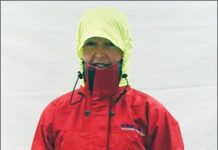
Womens Foul-Weather Gear

Preparing Yourself for Solo Sailing

How to Select Crew for a Passage or Delivery

Preparing A Boat to Sail Solo

Chafe Protection for Dock Lines

Waxing and Polishing Your Boat

Reducing Engine Room Noise

Tricks and Tips to Forming Do-it-yourself Rigging Terminals

Marine Toilet Maintenance Tips
- Sailboat Reviews
Pacific Seacraft 34 and 37
These bill crealock-designed voyagemakers have a reasonable turn of speed thanks to moderate displacement and a split underbody. relatively narrow beam makes for a seakindly motion, but reduces interior accommodations..
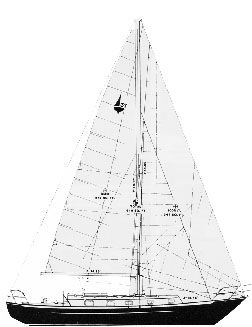
Originally known as the Crealock 34 and 37, this duo can be thought of as performance cruisers plotted somewhere on the continuum between heavy displacement cruisers and light displacement racers. Both have a seakindly motion and a good turn of speed. Now known as Pacific Seacraft Voyagemakers, they are part of a five-boat line ranging in size from 34 to 44 feet. The 37, introduced in 1980, was followed in 1984 by the 34. In this review we wanted to see how the 34 stacks up against its larger stable mate; for more specific information on the 37 see our earlier review of it.
The Company Pacific Seacraft was founded in 1976 by Henry Morschladt and Mike Howarth, who first produced 25-foot daysailers. Like many boatbuilders, the company suffered during the industry downturn of the 1980s, and the business was sold to Singmarine Industries, Ltd., of Hong Kong. It has been owned by an individual investor since 1998.
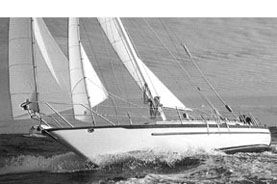
The company now is managed by Don Kohlmann, a veteran Americas Cup racer and former owner of Ericson Yachts. He said that 1,850 boats have been built and that the current annual production level is 40 to 50 boats. In addition to Pacific Seacraft models, the company also builds the Flicka and Dana, seaworthy 20- and 24-foot sailboats, and the 38T Fast Trawler.
Design Designer Bill Crealocks knowledge of sailing goes well beyond the theoretical. Following graduation with a degree in naval architecture from Glasgow University in Scotland, he spent eight years cruising the Atlantic and Pacific oceans aboard sailing yachts. He also served as sailing master on a 105-foot schooner undertaking a scientific expedition for the US Navy.
Eventually settling down on the California coast in 1958, he has since designed boats ranging in size from dinghies to a 100-foot catamaran. His clients have included Excalibur, Islander, Columbia, Westsail and Cabo Rico.
I estimate that about 8,000 boats have been built to these designs, he said.
The Pacific Seacraft 34 and 37 are notable for their clean lines, traditional, ocean cruiser appearance, and canoe sterns. In profile, both have gentle sheer lines and fairly low freeboard. The coachroofs are flat and the bronze opening portlights dominate the cabin sides. Both designs are very soft on the eyes.
In the 37, I had the luxury of drawing a boat not for a client but to represent what I would like for myself, Crealock said. It had to be nimble for local sailing but able to make reasonably fast ocean passages in safety and comfort. That meant that, above all, it had to be well balanced, and we devoted more time to that than any other aspect of the plan.
I have been studying balance, which I consider to be the most important element of design, since I began my career. The [early 1970s] Excalibur 26 was the first production boat in which I was able to attempt to produce an easily sailed boat.
I believe that there is a great difference between speed round the buoys and speed on an ocean passage with a crew consisting, perhaps, of an undersized, emaciated skipper and a mildly mutinous spouse. Thats when the boat must take care of the crew.
The keels are long cruising fins integrated with a skeg on which the rudder is hung. This makes for a more maneuverable boat than a full keel or a full keel boat with cutaway forefoot and Brewer bite, that is, a chunk removed from the keel forward of the rudder.
The canoe stern figures prominently in the design scheme, and is more pointed than the wider, more rounded sterns found on many Taiwan-built double-enders.
A canoe stern, if carefully designed and given sufficient overhang, said Crealock, can be efficient and attractive. When the going gets really tough your stern will probably have to serve as your bow. The combination of a canoe stern, which presents less area to the sea, and high-lift skeg reduces the chance of a broach when sailing downwind in heavy seas.
The 34 aimed at the same overall qualities as the 37, but proportionally was given a little more volume to take care of the extra gear which has become standard. Both were aimed at the sailor who knew that if one day he dreamed of cruising afar he had a boat to take him anywhere.
The boats displacement/length (D/L) and sail area/displacement (SA/D) ratios are nearly identical. The 37s D/L is 334.13; the 34s 333.19. The 37s SA/D is 15.66; the 34s 15.12.
Our boats look heavy on the D/Ls for two reasons, Kohlmann said. The overhangs are fairly long so the waterline appears to be short, but each pick up waterline quickly as they begin to move through the water. If we add the staysail areas the SA/D on the 34 becomes 18.38; the 37, 19.18.
A second point is that our displacement is calculated to be half load-half fuel and water, sails and store for a crew of four.
Crealock and Kohlmann take pride in an award made some years ago by Fortune magazine that, along with the F-15 fighter plane, listed the Crealock 37 as considered one of the 100 best products made in the US. It was the only sailboat on the list.
The most recent models to come off the production line are referred to as Voyagemakers. Standard equipment now includes Harken roller furling, a singlehanders package, B&G instruments, refrigeration, Ullman sails, Corian countertops and a Force 10 stove with oven and broiler.
Construction The 34 and 37 have similar laminate schedules. Hulls are solid fiberglass. Following application of an ISO-NPG gelcoat, a 3-ounce layer of chopped strand mat is wetted out with vinylester resin to prevent blistering. Kohlmann said that chopped strand eliminates the binder in rolled mat that has been identified as a contributor of water-solubles to the gelcoat/skin interface, a potential cause of blisters.
This layer is followed by 2415 bi-axial roving (24-ounce roving attached to 1.5-ounce mat) laminated with isopthalic polyester resin. Extra layers are added to the chainplate and keel attachment areas, at the rudderstock, and on the centerline. Hull thickness at the bottom is 7/8″.
A full-length interior pan is bonded to the hull with bi-axial roving. This structure provides stiffness to the hull and incorporates foundations for berths and other interior furniture. There are recesses molded in to accept bulkheads. Bulkheads, cabinetry and shelving are all bonded to the hull so, there are no floating interior components, Kohlmann said.
Weve never been keen on molded pan interiors because they tend to condense moisture, make access to parts of the hull difficult, make for a noisier boat, and severely limit customization, but Pacific Seacraft does a better job with pans than most production builders. Indeed, Pacific Sea-craft boats are probably the most expensive boats one can buy with a molded pan interior.
The tops of the bulkheads are bonded to the underside of the deck with bi-axial roving. To further strengthen the bulkheads, a teak beam is installed along the top of the bulkhead; it is secured with carriage bolts through the beams, tabbing, and the deck. The construction method results in a unitized structure that is unlikely to flex under heavy load.
The hull-deck joint is at the 4″ tall bulwark. The 3/8″ deck flange overlays the inward oriented 5/16″ hull flange and the two are bedded in 3M 5200 and secured with 1/4″ stainless steel bolts and backing plates located on 4″ centers. Additional structural support is provided by a 13/16″ teak caprail bedded in polyurethane and fastened with #10 stainless steel screws on 8″ centers. We doubt this joint will leak or deteriorate except in the event of a heavy collision.
The deck is laminated with mat and bi-axial roving and cored with Baltek AL600 balsa core. Areas in which hardware will be mounted are cored with marine grade plywood in place of balsa. Winches, the 31″ tall stanchions and other deck hardware are installed over predrilled holes that are sealed with epoxy before the bolts are pushed through; this helps prevent water from penetrating the lamination. All hardware is installed with stainless steel backing plates.

The chainplates are mounted outside the hull for easy inspection. The exterior plates are made of 1/4″ x 2″ type 304 stainless steel fastened with carriage bolts to 1/8″ thick stainless steel plates bedded on the hull interior. Their placement outboard makes for a wider staying base, which is stronger but makes for wider sheeting angles that affect pointing ability. But because most other modern boats of this size generally have a foot or so more beam, the Crealocks end up with about the same sheeting angles as a beamier boat with inboard chainplates.
The lead keel is fastened to a solid fiberglass stub and bedded in epoxy. Stainless steel backing plates bedded in epoxy are placed over each keel bolt, which is secured with nuts locked in epoxy.
The skeg extends below the rudder to protect against damage incurred during grounding or collision with a submerged object. Protection for the propeller and rudder is provided by a steel plate molded into the leading edge of the solid fiberglass skeg. The bottom of the stainless steel rudderstock is secured by a manganese bronze gudgeon through-bolted to the skeg.
Though expensive, we think the companys production process yields some of the strongest boats in the industry.
On Deck The deck layout and hardware also reflect the boats bluewater heritage.
The decks 18″-wide walkways are easily navigable because the shrouds are attached to outboard chainplates. Combined with long handrails and high lifelines, it is easy to have one hand on the boat in heavy seas.
The cockpit on the 37-footer is significantly larger and more comfortable than its little sister. The cockpit on the 34 is a near oval, and seats are 6′ 5″ long; seats on the 37 are 8′ 10″. Seats are 16″ wide and have ergonomic, outward-angled, 12″ backrests; however, space for legs and feet is at a premium because the footwell is only 28″ wide. We found the arched helm seat on the 34 more comfortable than the flat seat on the 37.
Both boats have storage in the stern for two propane tanks and a small compartment for a stern anchor and rode. Lazarettes add storage for fenders, dock gear and small sails.
Single-spreader LeFiell aluminum masts are finished with linear polyurethane paint rather than anodizing, which has become less popular due to EPA restrictions. The rig on the 37 is supported by 9/32″ 1 x 19 stainless steel wire, the 34 by 1/4″ 1 x 19 wire. Running backstays are standard, necessitated by the inner foretay.
The headstay and inner forestay are fitted with Harken furlers.
Six Harken two-speed self-tailing winches manage halyards and sheets led aft to Spinlock rope clutches. Early models had winches mounted on the mast; we prefer the single-handers package, with all running rigging led to the cockpit. This arrangement will be much appreciated when forced to reef in a heavy sea.
The mainsheet traveler is equipped with a Harken ball bearing traveler.
Accommodations The interior layouts are set up for offshore and are attractive. The common denominators are light flowing in through tempered glass to finely crafted and varnished teak woodwork accented by smooth white Formica and Corian surfaces. The feeling of openness is enhanced by 6′ 4″ inches of headroom in the saloon.
The 37 has significantly larger living spaces because interior volume increases exponentially with length.
The saloon on the 37 measures 14′ 9″ and is 8′ 8″ wide, compared to the narrower 10′ 10″ long saloon on the 34.
The comparatively narrow beams of these boats, plus their canoe sterns, make for interiors smaller than those on the floating condominiums marketed by the industry giants. Competitors offer boats 18″-24″ wider and with significantly more volume aft. This additional space allows them to build a second enclosed stateroom, and, in some cases, a second head. The tradeoff-and there are always tradeoffs-is a less seakindly motion.
The 37 sleeps six in comfort, the 34 four to six depending upon their size. Only the forward stateroom on either boat, however, is enclosed by a door.
Rather than a conventional V-berth, the 37 has a 6′ 6″ long by 5′ 11″ wide double berth offset to starboard, and a built-in chair with thick foam cushions to port. If one wishes, the chair can be eliminated and the size of the berth increased, an option wed consider since the 22″ wide seat is too narrow for the average adult. The 34 has a regular V-berth with an insert that creates a 78″ long by 84″ wide queen-size berth.
Quarterberths located in the stern of both boats are located aft of the chart tables. Though the space on the 34 is more than 7′ long, it is only 34″ wide and 20″ high. Though billed as a double berth, its really too tight for two adults. And, because the pillow area doubles as a seat for the navigator, this area may best be used for storage when not being used as a sea berth.
The quarterberth on the 37 is more spacious. In addition to being 8″ wider, it is taller and is located aft of the navigators fixed seat. Its still a tight fit for two adults. A privacy curtain would be an excellent addition on both boats.

The galleys are designed and equipped to cook a Christmas goose. Features include hot and cold pressure water and gimbaled Force 10 stainless steel two-burner propane stove with oven and broiler. Newer boats are equipped with an 8 cubic foot Seafrost BD3 12-volt refrigerator.
The optional $840 teak storage unit located over the sink interferes with sight lines but, especially on the 34, it adds significant storage space.
In the 37, the 6′ 4″ L-shaped dinette converts to a 50″-wide double berth. To port is a similarly sized 24″-wide settee that, if outfitted with lee cloths, could double as a sea berth.
By comparison, the 34 has 6′ 6″ settees to port and starboard; the port settee converts to a 48″-wide double berth. The dining table folds out of the way on the forward bulkhead.
Crealock located the water, fuel and waste tanks in the bow and stern, and amidships under the teak and holly cabin sole. While one normally doesn’t want excess weight in the ends, it hardly can be avoided in a smaller cruising boat.
The heads in each boat are nearly identical, though the larger boat has a compartment that measures 60″ on the diagonal. Neither boat has a shower stall, but the inconvenience will be of little consequence to cruisers in warm climates.
The engine compartment has 360-degree access to the Yanmar diesel-thats rarely seen. The companionway cover lifts to access the front of the engine; a removable panel in the cockpit sole provides access to the aft end of the engine and steering gear in a space large enough for a 6-footer.
Performance Our test boat was a 10-year-old 34 that we sailed on the north end of Puget Sound in relatively flat water and winds that varied from 8-12 knots. It was outfitted with its original Dacron sails; the quarter berth and lazarettes were filled with spare sails and gear.
While we expect most any boat to sail close to its designed speed in 10-15 knots of breeze, its always interesting to see how a boat performs in just 5-10 knots. If it has any performance in its blood, the boat will still move. In less than 5 knots of wind, odds are most of us will be motoring or listening to slatting sails.
The 34s dimensions and performance ratios are so close to the 37 that she appears to be proportionately faster than her big sister. Polar diagrams provided by US Sailing indicate that VMG (velocity made good) is 3.23 knots on a beat in 8 knots of wind, and 3.75 when wind speed increases to 10 knots. These predictions also indicate that the boat sails best on a broad reach at 116 of true wind in 8 knots of wind, and 140 in 10 knots.
We equaled or exceeded those predictions without a great deal of effort. The 34 easily sailed to weather within 50- 60 of the apparent wind, moving smoothly at 4.5-5 knots with a Yankee, staysail and full main. At approximately 70 to the apparent wind she buried her shoulder and surged forward at 5.2-5.5 knots. Footing off, she maintained the same speed until we sailed lower than 120, when she decelerated to 3.5 knots. A cruising spinnaker will improve performance.
The 34 powers smoothly and quietly. With the Yanmar 35-hp. diesel running between 1800-2400 RPM, she moves at 6-6.5. knots with an 11″ x 17″ three-blade propeller, consuming only 6/10 of a gallon of fuel per hour. Shes nimble under power, and turns more quickly in tight quarters than a traditional full-keel cruiser.
Pricing/Warranty The 37-foot Voyagemaker has a sticker price of $228,000; the 34 is priced at $199,000. Well-maintained used boats tend to maintain high resale values. At this writing, a 10-year-old 37 is on the market at $174,900; a 1992 34-footer for $142,500.
Pacific Seacraft warrants that it will repair or replace any part it manufactures, as well as associated labor costs, for a period of two years from date of sale. It extends coverage for the repair of gelcoat damage caused by osmotic blisters for 10 years, based on a depreciation schedule.
Conclusion These boats record 150-mile days in comfort in typical ocean conditions.
The reality of long-distance cruising is that one spends most of the time in the cockpit under sail, a large percentage of time belowdecks eating and sleeping, and a small percentage of time in the head. Considering those uses, either of these boats will meet the needs of the informed buyer.
The 34 is an excellent daysailer or distance cruiser suitable for four adults or a couple and two children. The cockpit is too small to seat more than four adults comfortably. However, as Crealock says, a small cockpit is a good thing if pooped.
The aft berth is most suitable as a single sea berth and storage area. The head is smallish.
By comparison, the 37s cockpit accommodates six, as will its sleeping quarters. The cook will appreciate the larger galley, and the navigator can perform his chores without fear of sitting on a sleeping crews head.
Any buyer considering purchase of a new Pacific Seacraft yacht will face a difficult decision because only $30,000 separates the price of the two. Considering an 8% interest rate on a 15-year loan, that translates to a monthly payment of $286.
A more difficult decision could be choosing between buying a four- to six-year-old 37 for $190,000-$200,000, or a new 34 for $200,000.
Its a tough choice, but wed take the used 37.
Also With This Article Click here to view “Used Boat Price History.” Click here to view “At A Glance.” Click here to view “Owners Comments.”
Contact- Pacific Seacraft, 1301 E. Orangethorpe Ave., Fullerton, CA, 92831, 714/879-1610, www.pacificseacraft.com .
RELATED ARTICLES MORE FROM AUTHOR
Leave a reply cancel reply.
Log in to leave a comment
Latest Videos
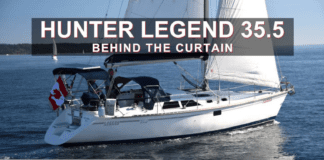
Hunter Legend 35.5 – Behind the Curtain

Whipping Line On Your Sailboat

Hallberg Rassy 42 – Behind the Curtain

The ICW – The Easiest Way – Sail to the Sun...
- Privacy Policy
- Do Not Sell My Personal Information
- Online Account Activation
- Privacy Manager
Great choice! Your favorites are temporarily saved for this session. Sign in to save them permanently, access them on any device, and receive relevant alerts.
- Sailboat Guide
Pacific Seacraft Crealock 37

Pacific Seacraft Crealock 37 is a 36 ′ 10 ″ / 11.3 m monohull sailboat designed by William Crealock and built by Pacific Seacraft starting in 1979.

- 5 / 8 Port Charlotte, FL, US 1994 Pacific Seacraft Crealock 37 $75,000 USD View
- 6 / 8 Port Charlotte, FL, US 1994 Pacific Seacraft Crealock 37 $75,000 USD View
- 7 / 8 Port Charlotte, FL, US 1994 Pacific Seacraft Crealock 37 $75,000 USD View
- 8 / 8 Port Charlotte, FL, US 1994 Pacific Seacraft Crealock 37 $75,000 USD View
Rig and Sails
Auxilary power, accomodations, calculations.
The theoretical maximum speed that a displacement hull can move efficiently through the water is determined by it's waterline length and displacement. It may be unable to reach this speed if the boat is underpowered or heavily loaded, though it may exceed this speed given enough power. Read more.
Classic hull speed formula:
Hull Speed = 1.34 x √LWL
Max Speed/Length ratio = 8.26 ÷ Displacement/Length ratio .311 Hull Speed = Max Speed/Length ratio x √LWL
Sail Area / Displacement Ratio
A measure of the power of the sails relative to the weight of the boat. The higher the number, the higher the performance, but the harder the boat will be to handle. This ratio is a "non-dimensional" value that facilitates comparisons between boats of different types and sizes. Read more.
SA/D = SA ÷ (D ÷ 64) 2/3
- SA : Sail area in square feet, derived by adding the mainsail area to 100% of the foretriangle area (the lateral area above the deck between the mast and the forestay).
- D : Displacement in pounds.
Ballast / Displacement Ratio
A measure of the stability of a boat's hull that suggests how well a monohull will stand up to its sails. The ballast displacement ratio indicates how much of the weight of a boat is placed for maximum stability against capsizing and is an indicator of stiffness and resistance to capsize.
Ballast / Displacement * 100
Displacement / Length Ratio
A measure of the weight of the boat relative to it's length at the waterline. The higher a boat’s D/L ratio, the more easily it will carry a load and the more comfortable its motion will be. The lower a boat's ratio is, the less power it takes to drive the boat to its nominal hull speed or beyond. Read more.
D/L = (D ÷ 2240) ÷ (0.01 x LWL)³
- D: Displacement of the boat in pounds.
- LWL: Waterline length in feet
Comfort Ratio
This ratio assess how quickly and abruptly a boat’s hull reacts to waves in a significant seaway, these being the elements of a boat’s motion most likely to cause seasickness. Read more.
Comfort ratio = D ÷ (.65 x (.7 LWL + .3 LOA) x Beam 1.33 )
- D: Displacement of the boat in pounds
- LOA: Length overall in feet
- Beam: Width of boat at the widest point in feet
Capsize Screening Formula
This formula attempts to indicate whether a given boat might be too wide and light to readily right itself after being overturned in extreme conditions. Read more.
CSV = Beam ÷ ³√(D / 64)
From BlueWaterBoats.org :
When “Gentleman Bill” Crealock (1920-2009) sat down to design the Crealock 37, he penned a yacht that would be ideal for coastal sailing as well blue water voyages. The goals were for speed and comfort without compromising seaworthiness, and indeed all of these characteristics have been well met with glowing accolades from their respective owners, some of whom have circumnavigated.
“The 37 was, throughout, aimed at those people who, while wanting a pleasant boat to sail locally, just might want one day a boat able to take them in safety to any part of the world – and this with as much speed and comfort as possible without detracting from seaworthiness. I consider crew fatigue to be a major enemy of seaworthiness, and this meant an easy motion, dryness, strength, windward ability, a comfortable deep cockpit, a safe interior and, above all, ease of handling and balance with or without steering aids. With a small crew, possibly no longer athletically endowed, these are what make for fast passages.” – Bill Crealock
The design for an economical yet capable bluewater cruising yacht was initially commissioned by Clipper Marine in the 1970s who were already producing a series of trailer-sailers designed by Crealock. As it turned out, the company went broke before any hulls were produced.
The molds were acquired in 1976 by a boatbuilding concern called Cruising Consultants who produced the first sixteen “Crealock 37s” between 1978 and 1979. In 1980 Pacific Seacraft entered the scene by buying the molds and beginning steady production. By 1993 Pacific Seacraft had rebranded the model the Pacific Seacraft 37 and the boat continues to be in production with the factory putting the total count near 200 boats. (The hull numbers start at #101, with Pacific Seacraft hulls beginning at #117).
The Pacific Seacraft “Crealock” 37 has become highly regarded as one of the all-time classic cruisers and in 1992 the yacht was inducted into the American Sailboat Hall of Fame.
Boat Configuration
The Pacific Seacraft 37 is a handsome boat with a traditional look. It has a low freeboard, a large bow overhang, and a canoe stern. The rig is in a cutter configuration, a favorite among blue water cruisers. All the sail control lines are fed back to the safety of the cockpit. Under the waterline is a long fin keel and a strong well protected skeg hung rudder with a completely protected propellor.
Construction
True to Pacific Seacraft tradition, the 37 is a very strong boat. Construction is conservative and well proven. The hull is solid fiberglass, with the exception of some hulls had the optional balsa or foam coring for insulation purposes only.
Early hulls are not completely immune from osmotic blisters, a common problem in the 1980s boat building era. Hulls from 1988 onwards employ a vinylester resin on the outer layer in order to prevent blisters. In 1993 the original mat and woven roving was replaced with biaxial roving to comply with a change in ABS standards. The hull is supported by a full length liner, bonded into place in numerous points. Very few boats have reported structural damage, even after hard groundings.
The deck is plywood cored and joins the hull with a molded bulwark forming a box joint that is strong and dry, this joint is finished by a teak caprail. Deck delamintaion have not been a problem, even on aged boats.
The mast is deck-stepped and a compression post is incorporated into the main bulkhead which in turn is glassed and bolted into place.On the fin keel hangs the cast lead ballast externally bolted with large stainless bolts.
Sailing Characteristics
The boat is well balanced, and can be easily handled by a small crew or single handed. It is notable that boat speed under sail is faster than its displacement/length numbers betray, Crealock himself commented “beware the numbers game”. The boat is narrow and heels early, lengthening its waterline significantly. Many cruisers report consistent 6 knots on long passages, maintaining speed when many lighter and theoretically faster boats get pushed around by building seas. On long passages, the sea-kindly nature of the Pacific Seacraft 37 in practice leads to a less fatigued crew which often equates to faster overall passages.
Under storm conditions, the boat has a reputation of taking care of its crew. Crealock himself tells of two such incidents, “we had reports from two 37 owners caught out under just such conditions, in each case running for their lives under bare poles before heavy wind and seas hitting the peg at 12 knots when surfing. Both made the same remark; steering was so easy it would have been more fun with a tiller.”
Buyers Notes
Older 37s have aged well, especially taking into account many have sailed far and wide. It is noted that the strong construction and the boat’s seakindliness have contributed to maintaining the boat’s integrity through the years. From a production standpoint, it is important to note the change made in 1988 to a vinylester resin on the outer layer for osmotic blister protection. Some owners have reported problems with the bilge located aluminum fuel tanks, both with accelerated corrosion as well as seawater contamination. The water tanks which are built as part of the hull liner and should be carefully inspected. Generally the deck fittings selected by Pacific Seacraft are of top quality, however the overhead hatches made by Bowmar are prone to leaking.
Used boats are in good demand and prices have remain relatively high.
Links, References and Further Reading
» Cruising World Magazine, Apr 2011, Crealock 37 Review by Jeremy McGeary » Sailing Magazine, Dec 2001, Used Boat Notebook » Pacific Seacraft Official Site, Pacific Seacraft 37
Embed this page on your own website by copying and pasting this code.

Discover Related Sailboats


Blue Water Boats
This collection of capable blue water boats features time-tested sailboats with rich histories.

Valiant Esprit 37

Fast Passage 39
Southern cross 39.

Pacific Seacraft 37

Pacific Seacraft 34

Pacific Seacraft 40

- About Sailboat Guide
©2024 Sea Time Tech, LLC
This site is protected by reCAPTCHA and the Google Privacy Policy and Terms of Service apply.

- News & Views
- Boats & Gear
- Lunacy Report
- Techniques & Tactics
Pacific Seacraft 37: Crealock’s Creation
Originally dubbed the Crealock 37 after its designer, “Gentleman Bill” Crealock , this boat is now deemed a conservative cruiser, though when first conceived it was considered a more cutting-edge performance cruiser, thanks to its long fin keel and skeg-hung rudder. Molds to produce the boat were originally created by Clipper Marine, which went bankrupt before building could begin. The molds were acquired by a firm called Cruising Consultants, which launched 16 hulls in 1978 and ’79 before selling out in turn to Pacific Seacraft . Pacific Seacraft produced the boat in Fullerton, California, for 27 years before closing its doors in 2007, whereupon a marine archeologist, Stephen Brodie, acquired the company name and tooling for several boats, including the 37, and shifted production to North Carolina.
Pacific Seacraft has long been renowned for quality work, and this is reflected in the contruction of the 37, which has been steadily upgraded over the years. Prior to 1993 hulls were solid laminate composed of mat and woven roving and decks were cored with plywood; subsequently stitched bi-axial fabrics have been employed and decks have been balsa-cored with plywood interposed anywhere hardware is installed. All hardware is through-bolted on backing plates with fastener holes carefully sealed in epoxy beforehand. More recently the hull laminate has also included a layer of Kevlar fabric to increase impact resistance and since 1988, to resolve issues with blistering, vinylester resin has been used in exterior layers.
In some cases PSC 37 hulls also have layers of foam or balsa included in the laminate as insulation. These optional insulation cores are added on top of the regular lay-up, so these boats, besides having slightly less interior volume, are both somewhat heavier and stronger than their siblings.
The hull is stiffened with a molded pan riven with apertures that allow it to be securely glassed in place. The pan incorporates major furniture components, the engine beds, and also the sides and bottoms of the water tanks, which are covered with Formica-faced plywood lids. The main bulkhead is tabbed to both the hull and deck and is also through-bolted to a teak deck beam. All partial bulkheads, cabinets, and shelving are likewise glassed to the hull.
The ballast is external lead, which is epoxied and bolted to a solid keel stub with stainless-steel keel bolts supported by stainless-steel backing plates that are also bedded in epoxy. The rudder skeg also has a stainless-steel plate molded into its leading edge for extra strength. The deck joint, meanwhile, is on an inward flange atop a 4-inch high bulwark, is bedded in adhesive sealant, secured by stainless-steel bolts and backing plates, and topped by a heavy teak caprail.
Besides being reasonably heavy, the PSC 37 is relatively narrow with long overhangs and consequently has an easy motion and is not inclined to pound in head seas. It also tracks very well and has great ultimate stability. Reportedly it doesn’t bury its rail until heeled to 35 degrees and achieves maximum righting moment at 75 degrees, with only a small decrease at 90 degrees, when its mast is parallel to the water. Its AVS is an impressive 140 degrees. It is also a very attractive boat, with well balanced lines that appeal to a broad spectrum of sailors.
Like any boat with a short waterline, the PSC 37 sails faster than its D/L ratio suggests and is certainly faster than old CCA designs of similar size, thanks to its split underbody and somewhat lighter weight. In spite of its stern overhang and narrow canoe transom, many owners report hitting 10 knots or better surfing down big waves. The boat’s shrouds are secured to outboard chainplates through-bolted to the hull (a very strong installation), but its narrow beam still allows for decent sheeting angles, so apparent wind angles when closehauled can usually be kept within 40 degrees sailing in flat water. Note however that boats equipped with the optional (and quite popular) shoal-draft Scheel keel, which features a flared ballast bulb, are slightly less closewinded. Most boats have cutter rigs, though a few were also built as sloops and yawls. Most also have wheel steering, though the original design called for a tiller.
Thanks to its narrow beam and pinched hindquarters, the PSC 37 has limited interior space and a rather straightforward lay-out. The forward stateroom does seem large and boasts a very comfortable offset Pullman double, but beyond this berthing is limited to settees in the saloon (the dinette table on the starboard side can be converted to form a double berth) and a roomy quarterberth that is nowhere near wide enough to be a double. The nav table just forward of the quarterberth has its own dedicated seat, so at least the navigator need not sit on anyone’s head while working. Headroom throughout is well in excess of 6 feet, courtesy of the rather tall cabinhouse, and ventilation is very good. The interior finish is neat and traditional, with lots of teak trim. Joinerwork is high quality, but not flashy.
Over the years the PSC 37 has been equipped with various engines, all of them diesel fueled. The smallest was a 24-hp Volvo, which probably isn’t strong enough in some situations; the largest, standard since the late 1980s, is a 50-hp Yanmar, which is probably more powerful than necessary, particularly given the boat’s rather small fuel tank. This, it should be noted, is aluminum and is situated in the bilge, where it reportedly suffers corrosion over time. Fortunately, the tank is relatively easy to access and can be removed without dismantling or destroying any joinery.
Engine access is also superb, as the cockpit floor can be unbolted and removed, putting all parts of the engine and the stern tube within easy reach. On early boats with wheel steering the pedestal must first be removed before lifting the cockpit floor, which is a huge hassle, but later, after wheel steering became standard, the floor was redesigned to make this unnecessary. On all boats the engine can also be accessed at the front through the companionway and via a panel on the port side.
To sum up, the PSC 37 is an extraordinarily strong, well built ocean boat and is priced accordingly. It makes an ideal bluewater cruiser for a couple and also works well as a coastal cruiser for a small family. For those interested only in a coastal boat, it may be a bit heavy and expensive, but compared to many other lighter, less expensive boats it does hold its value well over time.
Specifications
LOA: 36’11” LWL: 27’9” Beam: 10’10” Draft -Standard keel: 5’6” -Scheel keel: 4’5” Ballast: 6,200 lbs. Displacement: 16,000 lbs. Sail area -100% foretriangle: 573 sq.ft. -Cutter: 708 sq.ft. -Yawl: 619 sq.ft. Fuel: 40 gal. Water: 95 gal. D/L ratio: 335 SA/D ratio -100% foretriangle: 14.41 -Cutter: 17.80 -Yawl: 15.57 Comfort ratio: 33.71 Capsize screening: 1.72 Nominal hull speed: 7.1 knots
Typical asking prices: $100K – $230K Base price new: $336K
BoaterMouth link: here
Related Posts

- DEAD GUY: Bill Butler

- NORTHBOUND LUNACY 2024: The Return of Capt. Cripple—Solo from the Virgins All the Way Home
Here’s a Youtube video of our Pacific Seacraft 37:
https://www.youtube.com/watch?v=WoBoVyLMPM8&feature=youtu.be
More information can be found here:
http://www.pacificseacraft37.com
I believe I currently have the original plans for this boat!!! W.I.B. Crealock 1976 are what is on the blueprints that I have. I have them listed on Ebay for sale. If you would like to speak to me about them, please call me. 360 582 6308 Deborah
Leave a Reply Cancel Reply
Save my name, email, and website in this browser for the next time I comment.
Please enable the javascript to submit this form

Recent Posts
- MAINTENANCE & SUCH: July 4 Maine Coast Mini-Cruz
- SAILGP 2024 NEW YORK: Lifestyles of the Rich and Famous
- MAPTATTOO NAV TABLET: Heavy-Duty All-Weather Cockpit Plotter
Recent Comments
- Charles Doane on SAILGP 2024 NEW YORK: Lifestyles of the Rich and Famous
- Pete Hogan on SAILGP 2024 NEW YORK: Lifestyles of the Rich and Famous
- Thanks, Dr_ma c k(@ y a h o O )C o M on THE INVASION OF ANGUILLA: A Comedy of Errors, Caribbean Style
- John Stone on DEAD GUY: Donald M. Street, Jr.
- Charles Doane on DANIEL HAYS: My Old Man and the Sea and What Came After
- January 2024
- December 2023
- November 2023
- October 2023
- September 2023
- August 2023
- February 2023
- January 2023
- December 2022
- November 2022
- September 2022
- August 2022
- February 2022
- January 2022
- December 2021
- November 2021
- October 2021
- September 2021
- February 2021
- January 2021
- December 2020
- November 2020
- October 2020
- September 2020
- August 2020
- February 2020
- January 2020
- December 2019
- November 2019
- October 2019
- September 2019
- August 2019
- January 2019
- December 2018
- November 2018
- October 2018
- September 2018
- August 2018
- February 2018
- January 2018
- December 2017
- November 2017
- October 2017
- September 2017
- August 2017
- February 2017
- January 2017
- December 2016
- November 2016
- October 2016
- September 2016
- August 2016
- February 2016
- January 2016
- December 2015
- November 2015
- October 2015
- September 2015
- August 2015
- February 2015
- January 2015
- December 2014
- November 2014
- October 2014
- September 2014
- August 2014
- February 2014
- January 2014
- December 2013
- November 2013
- October 2013
- September 2013
- August 2013
- February 2013
- January 2013
- December 2012
- November 2012
- October 2012
- September 2012
- August 2012
- February 2012
- January 2012
- December 2011
- November 2011
- October 2011
- September 2011
- August 2011
- February 2011
- January 2011
- December 2010
- November 2010
- October 2010
- September 2010
- August 2010
- February 2010
- January 2010
- December 2009
- October 2009
- Boats & Gear
- News & Views
- Techniques & Tactics
- The Lunacy Report
- Uncategorized
- Unsorted comments
JavaScript seem to be disabled in your browser.
You must have JavaScript enabled in your browser to utilize the functionality of this website.
Edwards Yacht Sales

- 866.365.0706
1989 Pacific Seacraft Crealock 34
Yacht price.

- Email Broker
- Call Broker

PACIFIC SEACRAFT 34 World Renowned Designer William Crealock
The Pacific Seacraft 34 was recently named by Cruising World as one of the top seven cruising designs under $100k.
SEA CHANGE is presently located on the hard at Panamarina on the Caribbean Coast of Panama Within 40 miles of the sailing mecca San Blas Islands Solar Panels w/controller Engel Refrigeration Force 10 Propane Stove Manson Supreme Anchor Lofrus Tigress 12V Windlass Garmin Chartplotter with AIS New House and Starting Batteries New Bimini Frame 'n Sunbrella Canvas Raymarine EV-100 Tiller Autopilot (new, needs install) Wind Pilot Pacific Wind Vane
Sea Change spent most of her life on Fresh Water Lake Superior Hull #124 of the Crealock Pacific Seacraft 34 build Previous USCG Doc #939847
"A handsome, nimble and capable double-ender by legendary designer Bill Crealock, the Pacific Seacraft 34 is well proven, with scores of ocean crossings in its wake." John Kretschmer, Cruising World Review. 2017.
Crealock 34's have classic proportions and lines, with a modern fin keel and tough skeg hung rudder. Her double-ender design lends itself to a very comfortable ride in heavy seas.
Specifications
Descriptions, basic information, dimensions & weight, tank capacities, accommodations.
- View Option

LOA: 34.08 feet LWL: 26.25 feet BEAM: 10.0 feet DRAFT: 4 feet 10 inches Displacement: 13,200 lbs. Ballast: 4,800 lbs.
Yanmar Model 3HM35F Naturally Aspirated (approx 2100 hours) Kanzaki Transmission Model KBW10 Ratio: 2.14:1 New Racor Fuel Filter and Secondary hosings
- New Garmin 740s with Depth Sounder and AIS Connected
- Standard Horizon GX2200 VHF Radio at Nav Station
- Raymarine EV100 Tiller Pilot (new, needs install)
- Autopilot Autohelm ST 4000 (not reliable)
- Windpilot Pacific Wind Vane installed 2016
- 190W Solar Panels w/Morningstar 30A controller (March 2019)
- New House and Starting Batteries (March 2019)
- 12VDC to 220VAC Invertor (2000 watt)
- Lofrans Tigres 1500 12VDC Windlass new and installed 2016
- 12VDC and 110VAC Electrical Panel w/breakers at Nav Station
- Manson Supreme 35 lbs primary new in 2013
- Lofrans Tigres 1500W 12VDC Windlass new in 2016
- Windlass control on deck and wired remote inside companionway
- Main Anchor Chain BBB 8mm - 45 meters new in 2016
- Main Anchor Rode 100 meter 3 strand nylon
- Dual Anchor Roller
- Secondary Bruce anchor with 10 meters of chain and 100 meters 3 strand nylon
- Stern Anchor is a Danforth with 10 meters chain and 3 strand nylon
- Back up CQR Anchor
- Main Sail - Serviced in 2015 w/new Mainsail cover in 2013
- Genoa on Profurl Roller Furling Good Condition
- Staysail Good Condition
- Spinnaker Like New
- Storm Sail Like New
- Extra Sails - Main and Jib
- Offshore Commander Life Raft by Revere new in 2012 (needs re-cert)
- Life Jackets
- Life Sling on Stern Rail
- Two (2) EPIRB's
- Jack Lines w/harnesses
"After the boat was first launched as the Crealock 34 in 1979, Pacific Seacraft introduced a fifth model years later, a scaled-down version of the popular PS 37. Though expensive at the time, the 34 was another success story for one of America?s premier builders, and hundreds of boats were built in the company?s yard in Santa Ana, California. There is always a good selection of used boats available for less than $100,000. Another nice perk for used-boat buyers is that the 34 is back in production at the reincarnated Pacific Seacraft yard in Washington, North Carolina, providing an outlet for parts and advice.? John Kretschmer , Cruising World Review 2017.

Presented by
Kevin welsh 18 listing(s).
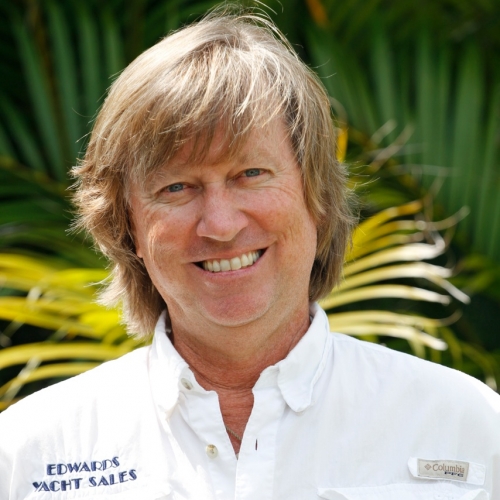
- 321.693.1642 727.449.8222
- View Profile
Manufacturer
Length Range Length Range
Year Range Year Range
Price Range Price Range
QUICK SEARCH BY:
Buyer services, featured yacht.

2019 Monachus Issa 45

2011 Meridian 391 Sedan

1996 Tiara Yachts 3500 Express

2018 Destination Yachts houseboat

2008 Sea Ray 47 Sedan Bridge

2007 Sea Ray Sundancer 40

1985 Morgan 31 Off Shore Fishing Cuddy

2002 Linssen 470 Grand Sturdy

2005 Carver 53 Voyager

1981 Hatteras 48 Motor Yacht

2007 Meridian 391 Sedan

2015 Lagoon 450 F

1985 Ocean Yachts 55 Super Sport
- Google Plus
- Boats For Sale
- Brokerage Services
- Sold Yachts
Whether you are buying or selling your next boat or your first boat, one of Edwards Yacht Sales 45+ Professional Yacht Brokers throughout the Southeast are here to assist. Since 2003 we have acted as our clients trusted advisor throughout the entire process from shopping, to making an offer, to sea trial and survey, to closing.
Corporate Office: 510 Brookside Drive Clearwater, FL 33764
Email: [email protected]
Phone: 727.449.8222 Toll Free: 866.365.0706 Fax: 727.298.0456
Copyright © 2024 Edwards Yacht Sales Do Not Sell My Personal Information Powered by YachtCloser

We have placed cookies on your device to help make this website better.
You can use this tool to change your cookie settings. Otherwise, we’ll assume you’re OK to continue.
Some of the cookies we use are essential for the site to work.
We also use some non-essential cookies to collect information for making reports and to help us improve the site. The cookies collect information in an anonymous form.
To control third party cookies, you can also adjust your browser settings .
- BOAT OF THE YEAR
- Newsletters
- Sailboat Reviews
- Boating Safety
- Sails and Rigging
- Maintenance
- Sailing Totem
- Sailor & Galley
- Living Aboard
- Destinations
- Gear & Electronics
- Charter Resources

Crealock 37
- By Jeremy McGeary
- Updated: April 26, 2011
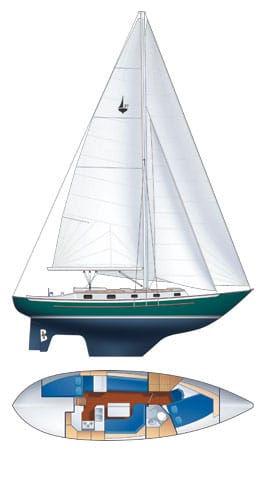
Here’s a 37-footer that might also be in contention for a pretty-boat award. It’s the product of designer Bill Crealock’s own experience sailing across oceans, and I happily defer to his judgment. I’d consider the Tayana 37 for this slot, but I think Crealock drew a prettier canoe stern than Bob Perry did on the Tayana. (Sorry, Bob.) Maybe it’s not quite as powerful, but it might also be a little more forgiving in a big quartering sea. I’ve not spent any getting-to-know-you time on a boat with a canoe stern, but I think it might be fun to do so.
It was built as a cutter and as a yawl. I fear the yawl might be a bit busy around the cockpit. I like the cutter rig for its versatility upwind and reaching. I’d dispense with a big genoa and use a modern asymmetric for extra downwind sail area.
Some of the early Crealock 37s were built with tiller steering, which might be a nice way to go. The tiller probably hogs the cockpit (which isn’t all that big) when you’re sailing, but it’d take up less space at rest than a wheel. Given the option, I’d rather carry a spare tiller than have to burrow under the cockpit to re-reeve a steering cable, though I might change my mind if the boat has a heavy helm (which I somehow doubt it has.)
Pacific Seacraft built the 37 with an internal pan liner. This worries me a bit because it makes lots of areas of the hull inaccessible. I like a boat built the old-fashioned way, piece by piece, which means it can be dismantled the same way if necessary. Still, Pacific Seacraft has a good reputation, and you have to put some faith in that.
Crealock 37 by Pacific Seacraft Price range: $119,000 (1983) to $219,000 (1999) More info: www.pacificseacraft.com
- More: keelboat , monohull , pacific seacraft , Sailboats , sailboats classic plastic
- More Sailboats

New Sailboat Brand: Mishi Yachts

For Sale: 2005 Tayana 48

For Sale: 2015 Catalina 355

For Sale: 1998 Hinckley 51
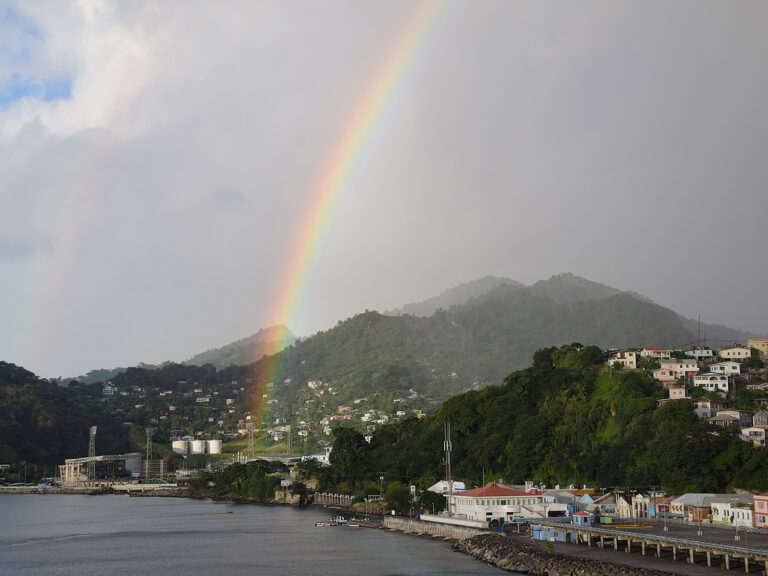
Hurricane Beryl Relief Efforts: How You Can Help

Gary Jobson To Talk U.S. Prospects in Upcoming World Sailing Competitions

Make Downwind Sailing Fun Again. Turn Off That Motor and Unfurl Your Kite!
- Digital Edition
- Customer Service
- Privacy Policy
- Email Newsletters
- Cruising World
- Sailing World
- Salt Water Sportsman
- Sport Fishing
- Wakeboarding
- Types of Sailboats
- Parts of a Sailboat
- Cruising Boats
- Small Sailboats
- Design Basics
- Sailboats under 30'
- Sailboats 30'-35
- Sailboats 35'-40'
- Sailboats 40'-45'
- Sailboats 45'-50'
- Sailboats 50'-55'
- Sailboats over 55'
- Masts & Spars
- Knots, Bends & Hitches
- The 12v Energy Equation
- Electronics & Instrumentation
- Build Your Own Boat
- Buying a Used Boat
- Choosing Accessories
- Living on a Boat
- Cruising Offshore
- Sailing in the Caribbean
- Anchoring Skills
- Sailing Authors & Their Writings
- Mary's Journal
- Nautical Terms
- Cruising Sailboats for Sale
- List your Boat for Sale Here!
- Used Sailing Equipment for Sale
- Sell Your Unwanted Gear
- Sailing eBooks: Download them here!
- Your Sailboats
- Your Sailing Stories
- Your Fishing Stories
- Advertising
- What's New?
- Chartering a Sailboat
- Pacific Seacraft Crealock 37
'Hero' , a Pacific Seacraft Crealock 37 Sailboat for Sale by owner Jim Seal
'Hero' , my Pacific Seacraft Crealock 37 is currently sailing in the Caribbean (since July 2021) and is scheduled to return to the US east coast late spring 2023.
Update! 'Hero' is now on the hard at Bert Jabins in Annapolis, MD, so interested parties can take a look at her there.
She has had all her systems upgraded and improved upon since we purchased her in 2015. We have plans for extensive land travel in the next few years and sadly will be offering her for sale.
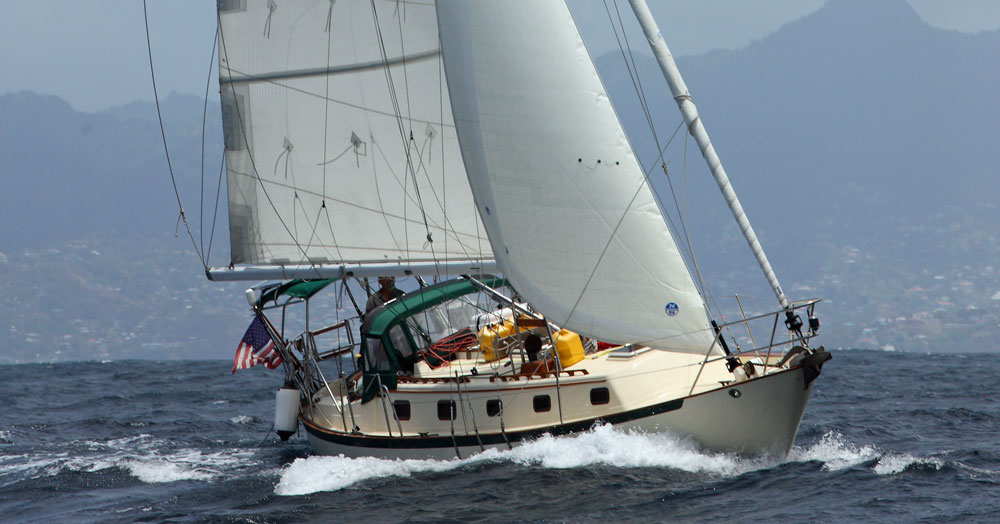
'Hero' is perfect for a liveaboard couple, and can accommodate 5-6 for overnights.
Her first owner kept her in freshwater near Burlington, Vermont, for the first 20 years, so she has avoided a lot of saltwater wear. She's a very stable and reliable vessel with classic good looks.
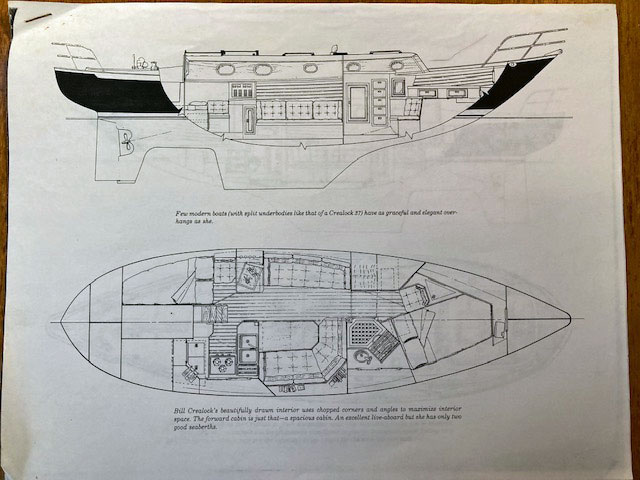
Material & Dimensions
- Designer: Wiliam Crealock;
- Fiberglass construction, Fin keel with skeg-hung rudder. Hull #252;
- Draft 5’6”. Bridge clearance 50’2”;
- Overall length 36’11”, Beam 10’10”;
- Waterline length 27’8”;
- Sail area 618 ft 2;
- Displacement 16,000 lbs. Lead ballast 6,200 lbs;
- Two 40-gallon water tanks, one 40-gallon fuel tank, one 15-gallon holding tank.
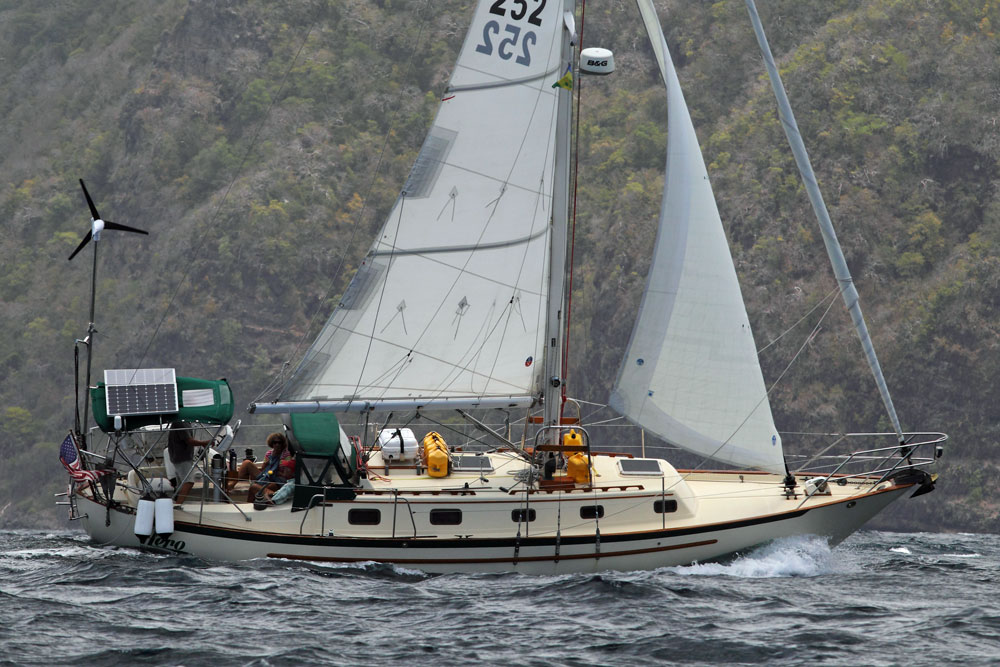
Sails, Rigging & Deck
- Main: 272 ft 2 , good condition. Two reefs, lazy-jack system;
- Primary jib: North Sails 452ft 2 , 125% 3Di Nordac Offshore Ply (2020);
- Staysail: North Sails 90% 3Di Nordac Offshore Ply (2021);
- Backup jib: Doyle high clew, Condition good;
- Asymmetric spinnaker: 860 ft 2 , with ATN Tacker;
- Orange Storm Trysail 86 ft 2 ;
- 32-inch diameter Edson wheel with leather cover;
- Block and tackle arm attached to wind generator pole for raising outboard engine onto rail;
- Standing rigging, both furlers, boom vang and all lifelines replaced;
- Barient 2-speed self-tacking main winches;
- Lewmar 30 two-speed winches mounted to the mast;
- Lewmar 30 self-tacking two-speed winches on the cabin top;
- Sunbrella bimini and dodger, new mainsail and windlass covers.
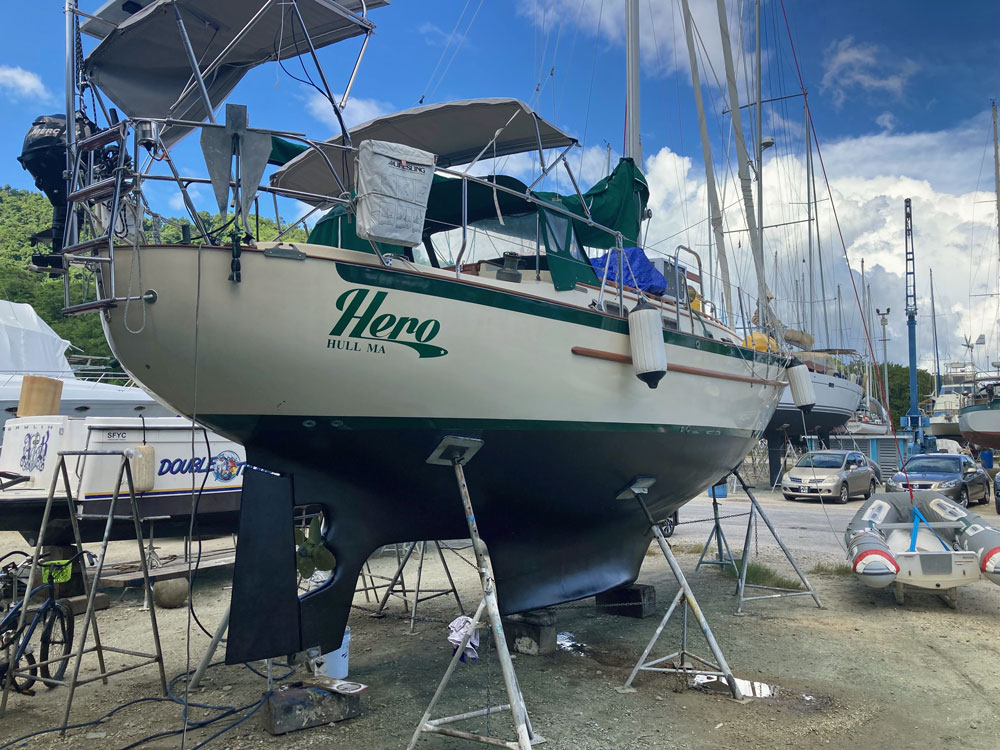
Engine & Mechanicals
- Yanmar 4JH2E 50 hp diesel, 2350 hours as of Feb 20, 2023;
- Variprop feathering prop (19” x 13 x 4-blade);
- 55 Amp alternator, spare alternator, starter and water pump included;
- Hot water tank, engine driven;
- Engine mounts, oil cooler, fuel injection pipes and exhaust elbow recently replaced;

Electronics, Navigation & Renewable Energy Equipment
- Chartplotter in cockpit: 12" display B&G Zeus 2, NMEA2000 network;
- C-Map US Coastal & Rivers Continental on Micro-SD 16 GB card, C-MAP MAX-N+ Electronic Chart Caribbean & Central America;
- B&G 4G Radar System, B&G Wind sensor;
- Vesper Marine WatchMate AIS with wifi;
- CPT Autopilot system;
- Airmar depth transducer;
- Scad water tank monitoring system;
- Battery bank: Four Firefly AGM 12 volt - new 2021. Total 464 Ah;
- Victron Precision Battery monitor system;
- Standard Horizons model GX1700 VHF, with remote radio and external speaker mounted in the cockpit;
- Pro Marine 2000 Watt inverter;
- 350 Watt solar array mounted to bimini; MPPT charge controller;
- 400 Watt Marine Kinetix wind generator mounted at stern;
- LED anchor, running and steaming lights;
- Iridium Go satellite system.
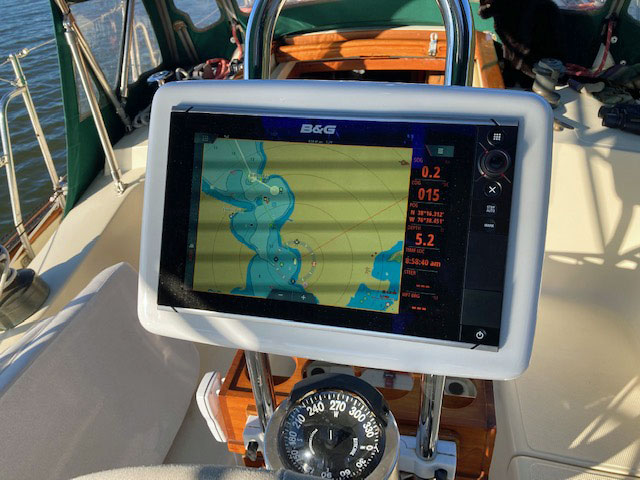
Ground Tackle
- Primary: 44 lb. Spade anchor with 80’ of 5/16" G40 high test anchor chain spliced to 220’ of ⅝” three-strand rode;
- Stern: 30 lb. Danforth on stern pulpit, with 15' of 5/16" G40 High Test anchor chain spliced to 90' of 5/8" 3-strand rope;
- Additional 300’ of 5/8" 3-strand rode accessible at bow as backup with spare Bruce anchor;
- Lewmar H3 Windlass, with wireless remote, new 2022;
- Snubber: 20' line with 6-foot long rubber elastic;
Interior/Galley/Comforts
- 'Hero' is a very clean boat;
- Two hatches and 10 ports for excellent air flow;
- All LED interior lighting, including red lighting for night sails;
- OzeFridge fridge/freezer combo. Compressor with twin cold plates, freshwater cooling. All refrigeration insulation replaced;
- Hot pressurized water (engine provided with 6 gallon tank) for hot showers;
- Spectra model 200T watermaker - 7 gallons of freshwater per hour;
- Interior analog clock and barometer;
- All interior and cockpit cushions replaced;
- Interior wood walls/tables refinished;
- Galley countertops and sink replaced with Corian;
- Galley and head faucets with hot and cold pressurized, filtered water;
- Durable Groco manual head;
- Handheld shower spray and freshwater foot pump in head;
- Galley has saltwater and freshwater foot pumps;
- Lee cloth on port side;
- Force 10 two-burner stove and oven;
- Force 10 propane fueled cabin heater;
- Two propane tanks secured in ventilated stern locker;
- Propane grill mounted to stern rail;
- Fusion Stereo AM/FM/CD/DVD Wifi player w/NMEA control at chartplotter, Infinity 8" speakers in the cockpit, Bose 101 speakers in the salon;
- 32-inch wifi TV mounted in the salon;
- Three 7-inch Caframo fans mounted in the salon and v-berth;
- Multiple USB ports and AC power access in cabin;
- Bimini and stern rail hardware replaced;
- Teak cockpit table with folding leaves.
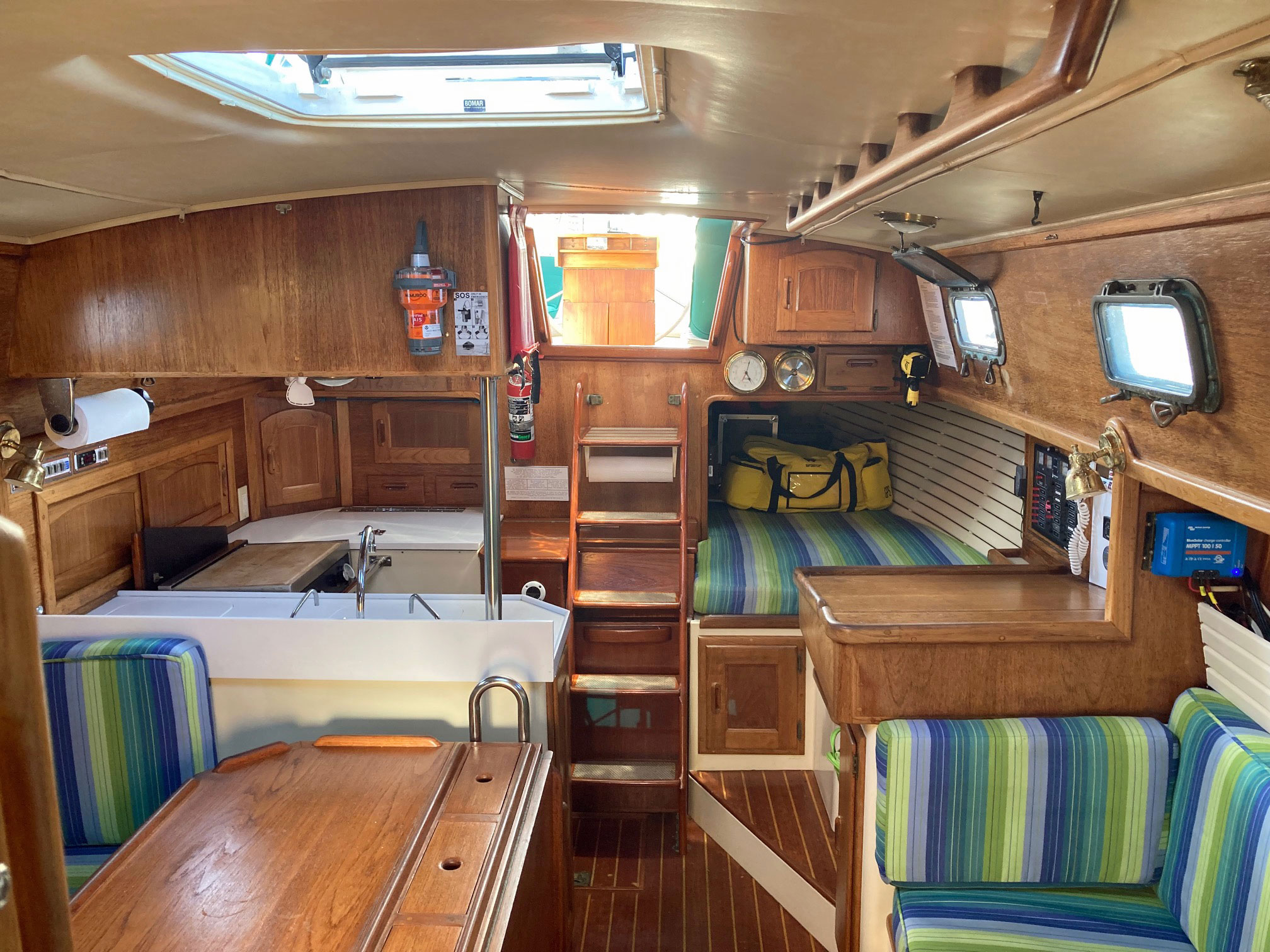
Safety Gear
- Datrex 4-person canister liferaft (new 2021), cradle mounted on deck;
- Switlik Man Overboard Module (MOM-8S) self-inflating ring with pole, light and weight;
- McMurdo EPIRB SmartFind G8 AIS registered through Dec 2023;
- Jacklines affixed along port and starboard cabin tops, harness tethers;
- Lifesling Throwable PFD;
- Electric bilge pump, Whale manual bilge pump;
- Emergency tiller steering;
- Para-Tech Delta Drogue - 48";
- Four fire extinguishers;
- Fire blanket stored near galley;
- High intensity spotlight, runs off C batteries or 12-volt boat system;
- Off-shore flares, smoke signal canisters and supplies in ditch bag.
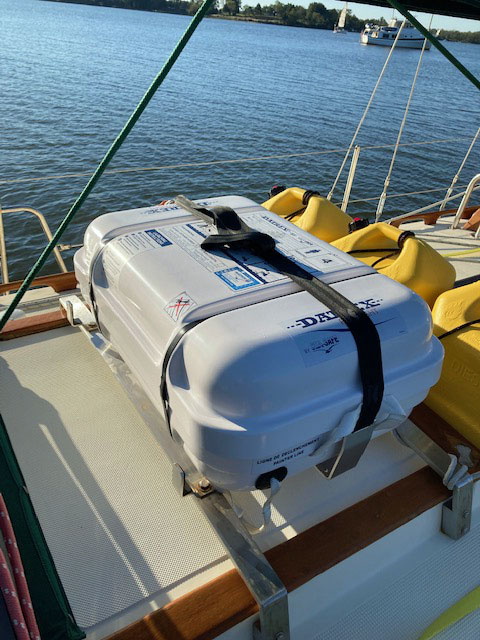
More Pics, Asking Price & Owner's Contact Details...
1 - hero's interior.
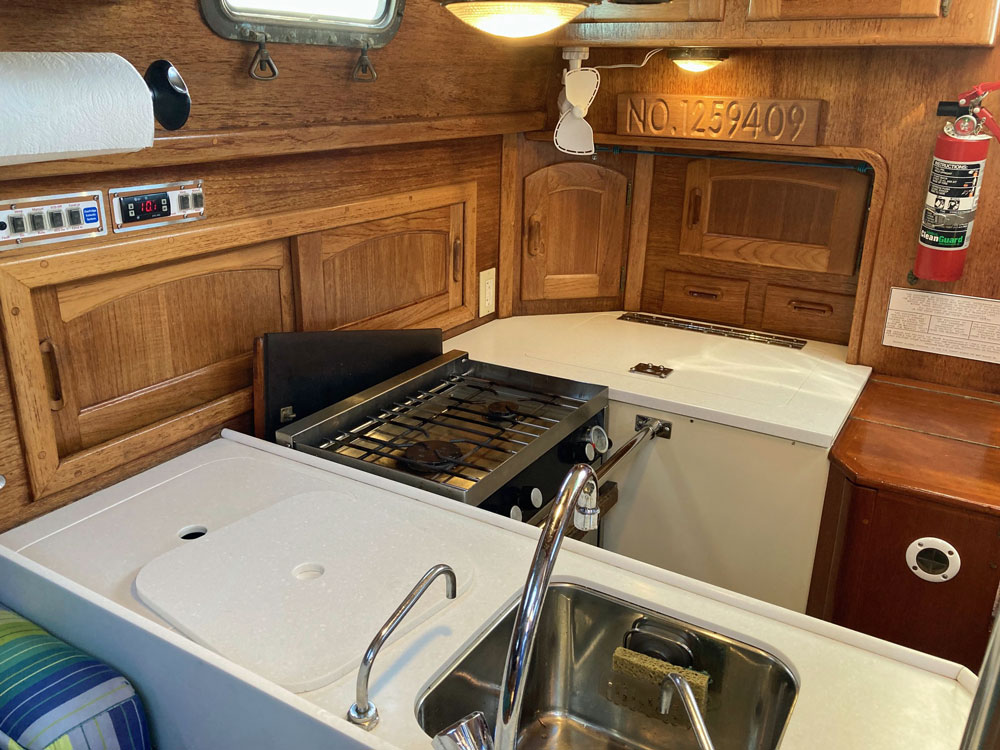
2 - Exterior Pics...
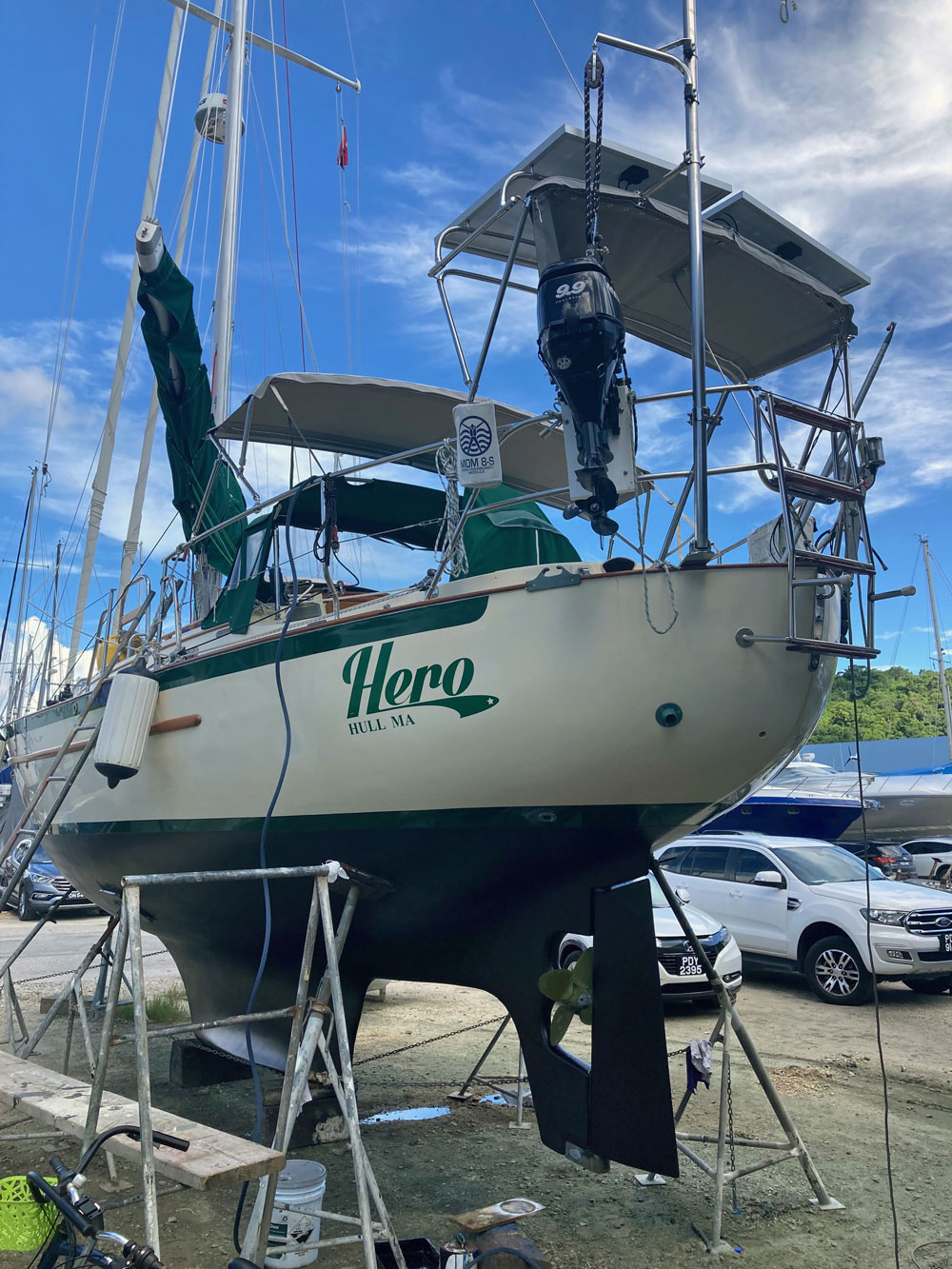
3 - Asking Price and Contacting the Owner
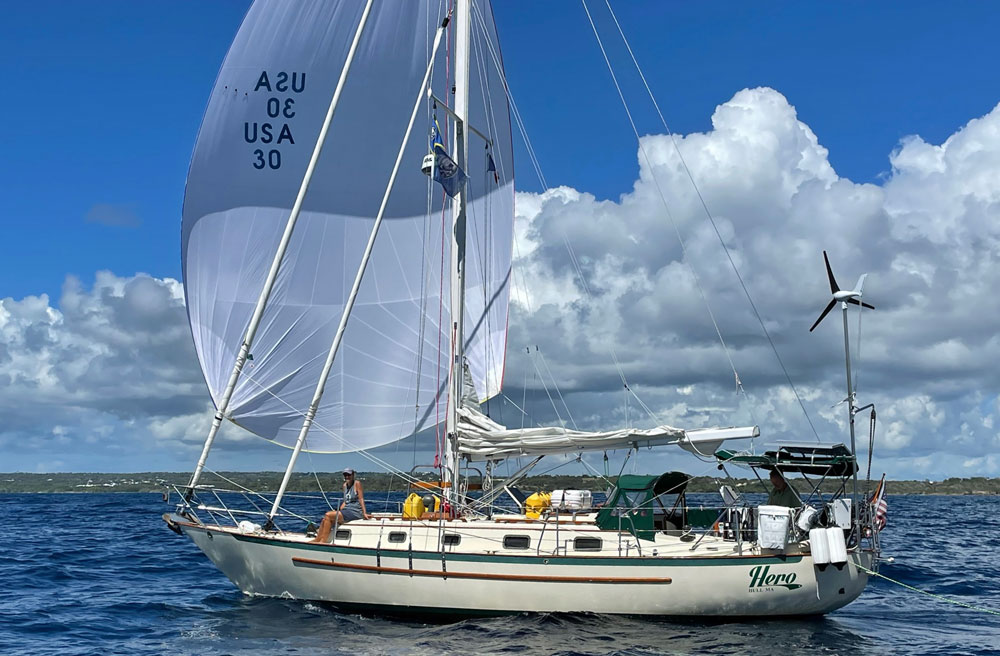
I'm asking $139,000 * for 'Hero' , my 1992 Pacific Seacraft Crealock 37 cutter.
* Now $125,000!
If you wish to get in touch, you can find my contact details here...
Owner: Jim Seal
What is the Pacific Seacraft Crealock 37 sailboat like to sail?
Based on Published Design Ratios for the Pacific Seacraft Crealock 37:
Her Sail Area/Displacement Ratio of 15.6 suggests that she will need a stiff breeze to get her going. In light conditions, unless you've got plenty of time on your hands, motor-sailing may be the way to go.
Her Ballast/Displacement Ratio of 38.8 means that she's likely to benefit from being reefed early to keep her sailing upright in a moderate breeze.
Her Displacement/Length Ratio of 334 tells us she is clearly a heavy displacement cruising boat. You can load her down with all your cruising gear and equipment and it will hardly affect her waterline.
Ted Brewer's Comfort Ratio of 33.4 suggests that the comfort of her crew in a seaway would be similar to that associated with the motion of a moderate bluewater cruising boat - a predictable and acceptable motion for most seasoned sailors.
More about Design Ratios...
Recent Articles
A Hunter Passage 42 for Sale
Jul 16, 24 01:41 PM
The Wauquiez Centurion 40 Sailboat
Jul 15, 24 04:50 AM
The Elan 431 Sailboat
Jul 13, 24 03:03 AM
Here's where to:
- Find Used Sailboats for Sale...
- Find Used Sailing Gear for Sale...
- List your Sailboat for Sale...
- List your Used Sailing Gear...
Our eBooks...

A few of our Most Popular Pages...

Copyright © 2024 Dick McClary Sailboat-Cruising.com
- Sign In or Register
- Boats for Sale
- Research Boats
- Sell a Boat
- Search Alerts
- My Listings
- Account Settings
- Dealer Advertising
- Pacific Seacraft Crealock 37
Pacific Seacraft Crealock 37 Boats for sale
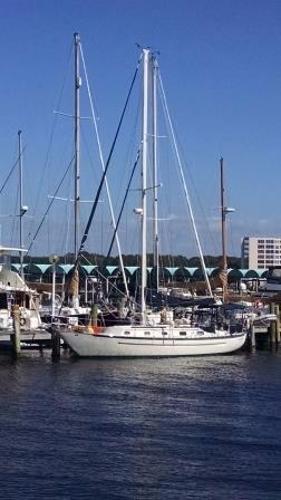
1994 Pacific Seacraft 37' Crealock
Make Pacific
Model Seacraft 37' Crealock
Category Cruiser Boats
Posted Over 1 Month
1994 Pacific Seacraft 37' Crealock FRESHWATER PACIFIC SEACRAFT 37 CREALOCK Ready for Offshore Cruising The Pacific Seacraft 37 (aka Crealock 37) is designed for cruising. She is a beautiful sailing ship that has excellent performance on all points of sail, is superbly constructed and time tested. This Crealock 37 is a superb high performance cruising yacht which incorporates all the best qualities an experienced sailor looks for in "a proper yacht" - seaworthiness, premium quality, very good performance, comfort and the ability to be sailed short-handed. The Pacific Seacraft Crealock 37 is a truly solid blue water cruiser built to go anywhere in comfort, good sea keeping abilities, and a pleasure to sail. "The Crealock 37 is an attempt to provide the weekender and the cruising sailor with a boat which will travel fast between ports under complete control, and which will yet remind him that the passage itself should be one of the pleasures of the cruise." --W.I.B. Crealock, Designer She has been the benchmark for world cruisers for 20 plus years and rightfully so. This voyager shocks even the most experienced sailors in lighter air. While everyone expects a passagemaker to perform well in 30 knots of breeze, most are genuinely surprised to see this lively lady tack gracefully in 2-3 knots of wind. The Pacific Seacraft 37 was designed by Bill Crealock, who is one of the few naval architects who can draw from the personal experience of 8 years of blue water cruising. His Pacific Seacraft 37 (aka Crealock 37) is legendary and was designed strictly for offshore cruising. She was recently inducted into the Cruising Yacht Hall of Fame. She is a beautiful sailing ship that has excellent performance on all points of sail, is superbly constructed and time tested. Here are the designer's comments, "When setting out to design the Pacific Seacraft 37, I had the luxury of doing it for myself without obligation to builder or dealer. I did not have to pay homage to interiors festooned with bunks, or revered classic features, or long waterlines or short, or distorted ends." --W.I.B. Crealock, Designer Owners Comments: Second owner and in Excellent Condition. Perfect couples cruising boat, very sea kindly, and extremely easy to handle
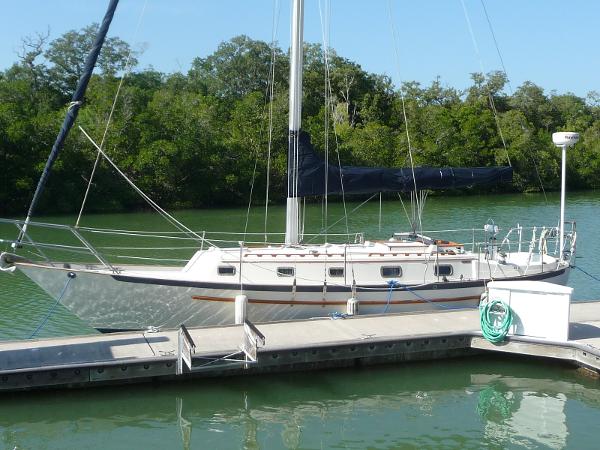
1992 Pacific Seacraft Crealock 37
Naples, Florida
Make Pacific Seacraft
Model Crealock 37
Category Sloop Sailboats
1992 Pacific Seacraft Crealock 37 There were major upgrades and repairs done on the boat in April, 2010 at the Pacific Seacraft plant in Washington N.C. All new standing riggingReplaced the fuel tank with newInstalled backstay insulators for SSB antennaRemoved the engine, inspected, serviced, painted and re-installedInstalled new sound insulation around the engineInstalled new Sea Frost DC cold plate refrigeratorNew Raymarine VHFNew Raymarine ST-60+ AWI and wind speedNew Raymarine 80C display with 4KW radar dome, GPSNew Raymarine ST-6002 auto pilotReplaced or serviced all seacocks, replaced pumps, hoses, bilge pumps and batteries New Raymarine Tridata for speed, depth and logForedeck is wired to add a electric windlass Call today!
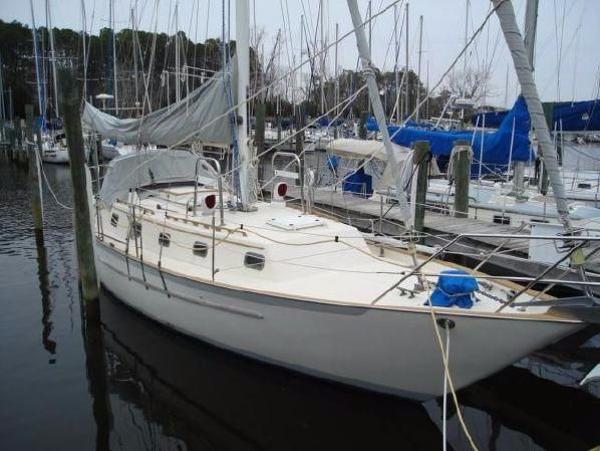
1991 Pacific Seacraft 37 Crealock
Clearwater, Florida
Model 37 Crealock
1991 Pacific Seacraft 37 Crealock "Sweet Thing" is the very desirable cutter rig with a shoal draft wing keel. Loaded with many recent cruising additions, she is turn key and ready for any use. She is an excellent boat for island getaways that will make some lucky couple a great cruising sailboat. She is well equipped with many recent and significant upgrades and has been professionally maintained. She is a true turnkey ready vessel awaiting her new owners to spend many more pleasurable years of cruising. Her owner recently purchased her, April, had her refitted and equipped for long range cruising, but circumstances have changed. So this totally updated and well equipped Pacific Seacraft is reluctantly offered for sale. This is W.I.B. Crealock's most revered design. His classic 37 was recently inducted into the sailing Hall of Fame! Stunning canoe stern, ample overhangs, ideal proportions and lean, sleek lines have made her a true modern classic. "The Crealock 37 is an attempt to provide the weekender and the cruising sailor with a boat which will travel fast between ports under complete control, and which will yet remind him that the passage itself should be one of the pleasures of the cruise." --W.I.B. Crealock, Designer April / May 2016 Additions & Services; Rocna 25 kg anchor, 140' 3/8 BBB chain 200' 5/8 braid rope rode. Fortress FX 37 anchor W/25' 3/8' chain and 200' 5/8' 3 strand rope rode. Lofrans Tigress electric windless 4 new Lifelene 80 Amp hour AGM batteries. Xantrex Battery charger/inverter Icom 802 SSB with Pactor modem Kayden 80 E 3.5 GPH water maker (2) 230 watt solar panels Cape Horn Self Steering wind vane Sanitation hoses replaced and head rebuilt. Hauled, bottom painted, aft cut less bearing replaced, prop balanced., new zincs Full engine service, including filters, fluids, impeller, etc Other Notable Features; 2012 Achilles Hard Bottom Dinghy w/Custom Cover 2012 Suzuki 4HP Four Stroke Outboard w/Custom Cover Autopilot Autohelm ST6000 Linear Drive Edson Teak Cockpit Table with Folding Leaves Raymarine C120 Chartplotter w/Radar
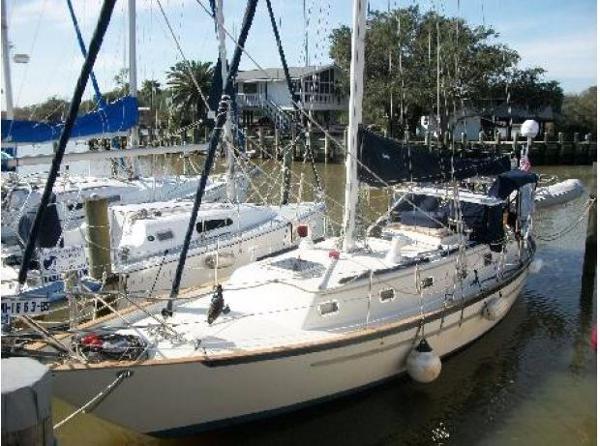
1994 Pacific Seacraft 37 Crealock
Fairgrove, Michigan
Category Sailboats
1994 Pacific Seacraft 37 Crealock 1994 PACIFIC SEACRAFT 37’ CREALOCKReady for Offshore Cruising The Pacific Seacraft 37 (aka Crealock 37) is designed for cruising. She is a beautiful sailing ship that has excellent performance on all points of sail, is superbly constructed and time tested. This Crealock 37 is a superb high performance cruising yacht which incorporates all the best qualities an experienced sailor looks for in "a proper yacht" - seaworthiness, premium quality, very good performance, comfort and the ability to be sailed short-handed. The Pacific Seacraft Crealock 37 is a truly solid blue water cruiser built to go anywhere in comfort, good sea keeping abilities, and a pleasure to sail."The Crealock 37 is an attempt to provide the weekender and the cruising sailor with a boat which will travel fast between ports under complete control, and which will yet remind him that the passage itself should be one of the pleasures of the cruise." --W.I.B. Crealock, Designer She has been the benchmark for world cruisers for 20 plus years and rightfully so. This voyager shocks even the most experienced sailors in lighter air. While everyone expects a passagemaker to perform well in 30 knots of breeze, most are genuinely surprised to see this lively lady tack gracefully in 2-3 knots of wind. The Pacific Seacraft 37 was designed by Bill Crealock, who is one of the few naval architects who can draw from the personal experience of 8 years of blue water cruising. His Pacific Seacraft 37 (aka Crealock 37) is legendary and was designed strictly for offshore cruising. She was recently inducted into the Cruising Yacht Hall of Fame. She is a beautiful sailing ship that has excellent performance on all points of sail, is superbly constructed and time tested.Here are the designer's comments, "When setting out to design the Pacific Seacraft 37, I had the luxury of doing it for myself without obligation to builder or dealer. I did not have to pay homage to interiors festooned with bunks, or revered classic features, or long waterlines or short, or distorted ends." --W.I.B. Crealock, Designer Owners Comments: Second owner and in Excellent Condition. Perfect couples cruising boat, very sea kindly, and extremely easy to handle in tight quarters. All line lead aft for easy sail handling. New
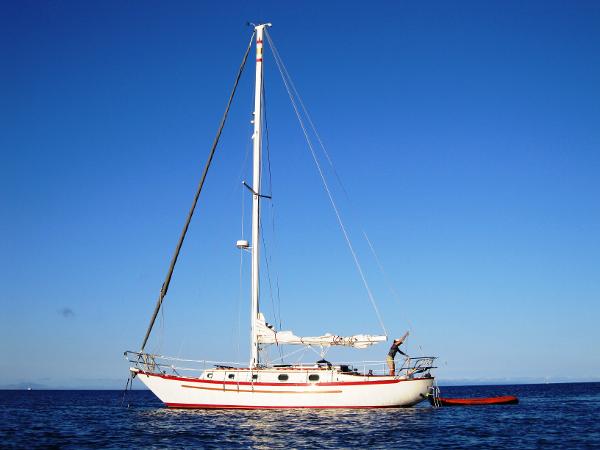
1983 Pacific Seacraft Crealock 37
Long Beach, California
1983 Pacific Seacraft Crealock 37 REDUCED OCTOBER 2015: Navy civil engineer military deployment overseas forces sale. All offers considered Carefully maintained example of one of the finest cruising boats ever designed and built. Sailboat Hall of Fame inductee in 2002, listed as one of Ferenc Mate World's Best Sailboats. Own a true classic, this boat turns heads and is guaranteed to start conversations at every anchorage and dock. Unique European tiller model ensures low maintenance, large open cockpit, easy engine compartment access through the removable cockpit sole, and a true and totally reliable sailing experience. Rig recently tuned, she sails a comfortable 5-6 knots under roller jib alone. Navy civil engineer military move overseas forces sale. All offers considered. Don't miss your opportunity to own an exceptionally clean and well maintained classic.

1992 Pacific Seacraft Crealock 37 There were major upgrades and repairs done on the boat in April, 2010 at the Pacific Seacraft plant in Washington N.C. 18" added to the base of the mast so there would be more head room under the boomAll new standing riggingReplaced the fuel tank with newInstalled backstay insulators for SSB antennaRemoved the engine, inspected, serviced, painted and re-installedInstalled new sound insulation around the engineInstalled new Sea Frost DC cold plate refrigeratorNew Raymarine VHFNew Raymarine ST-60+ AWI and wind speedNew Raymarine 80C display with 4KW radar dome, GPSNew Raymarine ST-6002 auto pilotReplaced or serviced all seacocks, replaced pumps, hoses, bilge pumps and batteries New Raymarine Tridata for speed, depth and logForedeck is wired to add a electric windlass Call today!
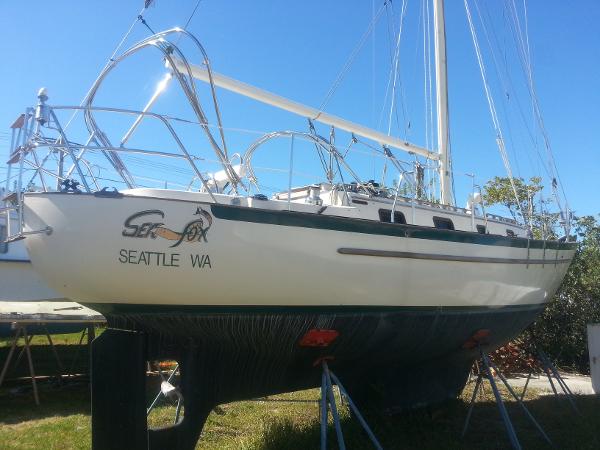
1993 Pacific Seacraft 34 Crealock
Cortez, Florida
Model 34 Crealock
1993 Pacific Seacraft 34 Crealock Shoal Draft - Blue Water Pacific Seacrafts have been known for their seaworthiness since 1984. Designed after the very successful Pacific Seacraft 37, this 34 focuses on safety and comfort with lively sailing performance. It’s an overall tough boat with a sea kindly nature very well suited for blue-water passage making. Once you reach your destination, its shoal draft of 4'1" will get you into places other blue-water boats won’t. The Canoe stern is not just for good looks either. The blue-water design allows this vessel to maintain speed and control in a following sea. While sailing upwind, her hull design continues to shine. This 34 Crealock is well balanced under sail which builds confidence in sailors who are not greatly experienced and gives a smile of pride to the experienced sailor. The rig is of cutter configuration, all control lines are feed back into the safety of the cockpit. Inside, there is 6’4? of headroom, a comfortably sized galley, and an interior that is well laid out for live aboard. There are berths for up to five, two in the V, two in the saloon settees, and a single seagoing quarter berth which doubles as a seat for the navigation table. Sea Fox is powered with a highly desirable 38hp Yanmar Diesel with low hours. Known in the sailing community for its fuel efficient, reliable design. Yanmar is the perfect complement to this solid seaworthy vessel. Equipped with the PSS Dripless Shaft Seal this propulsion system is blue water ready. As for running rigging – it’s all New! Waiting in the box for the new owners is a full set of color coded halyards, sheets and lines. The interior of Sea Fox is like new. The hand rubbed teak joinery in the cabin gives this rugged vessel a touch of elegance that sets off its overall majestic appearance. Sea Fox was hauled, cleaned and prepared for long term storage several years ago when the current owners realized they would not be able to sail for a while. They have sadly come to the conclusion they may not be able to sail again and are giving another eager sailor the opportunity. Sea Fox is currenly in the yard in Bradenton Florida and is easy to show! The owners are motivated to sell now that the decision has been made. Please call Captain Dale! You can reach me on my cell phone or email anytime with questions and to make an appointment for a showing! Thanks for your interest, Dale
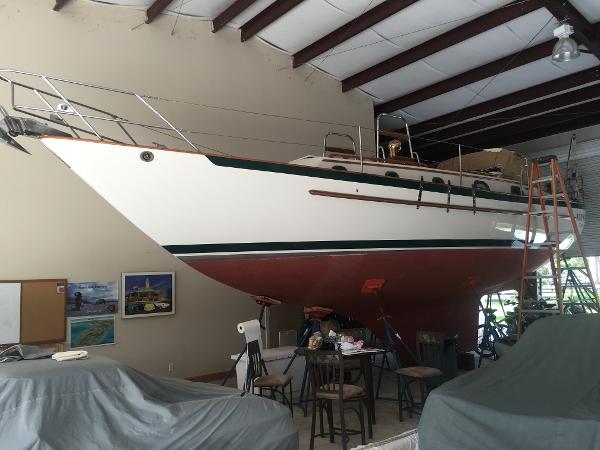
1988 Pacific Seacraft 37
Stuart, Florida
1988 Pacific Seacraft 37 We are proud to present for your consideration this truly remarkable Pacific Seacraft “Crealock” 37. Originally owned and sailed by actor William Hurt, her current owner returned Windflower to the Pacific Seacraft factory for a complete stem-to-stern, keel-to-masthead refit performed to 2010 standards. The two-year project included on-going dialogue with William I. B. Crealock, himself, and was the designer's final project. The meticulous owner has all receipts showing the total cost of re-fit was more than $250,000. Subsequent to Windflower’s factory departure all standing and running rigging, electronics, dodger/canvas, ground tackle and windlass were purchased and installed. Since her refit in 2010, Windflower has been lightly used, lovingly cared for and mostly stored indoors on the owner's property. A highly regarded design, the Crealock PS37 is recognized as an all-time classic and was inducted into the American Sailboat Hall of Fame. Windflower likely is the most stunning example of this design!

Category Racer Boats
Narrow Results
Current search reset all.
- Keyword: pacific seacraft crealock 37
- Pacific Seacraft (8)
- Pacific (1)
- Sailboats (4)
- Cruiser Boats (2)
- Sloop Sailboats (2)
- Racer Boats (1)
- Florida (6)
- Michigan (2)
- California (1)
- Search Title Only
- Has Picture
- Include Sold Listings
Showcase Ads

2006 Sea Ray 300 Sundancer
Washington, DC

2007 Malibu V Ride
Montgomery, TX

1978 Campbell 24' Cuddy Cabin

2010 Donzi 32 ZF Open
San Jose, CA

2019 MasterCraft X-24
Kimberling City, MO

2003 ProSports 2660 CC
Key Largo, FL
Create Alert
Please, name this search
Select Interval
Alert Successfully Created
| Pacific seacraft crealock
| |||||||||||||||||||||||||||||||||||||||||||||
IMAGES
VIDEO
COMMENTS
The Pacific Seacraft 37 was designed as the CLIPPER MARINE 37. But the company failed before any were built. It was first built in 1978 by Cruising Consultants Inc. of Newport Beach, CA, as the CREALOCK 37. Later (1980) built by Pacific Seacraft as PACIFIC SEACRAFT 37. Available as sloop, yawl or cutter.
Crealock's other well-known designs included the Westsail 42, the Crealock 34 and 37, the Pacific Seacraft 31 and the Dana 24. In 2002, the Pacific Seacraft 37, designed by Crealock, was inducted into the American Sailboat Hall of Fame. Crealock said the most unusual vessel he was ever commissioned to design was a large bottle.
William Crealock. 1920 - 2009. Author, lecturer and one of the world's most experienced, respected and prolific designers of offshore sailing yachts. William Ion Belton Crealock was born in England, and studied naval architecture at Glasgow University, but spent most of his life and career in the US.
Find Crealock boats for sale in your area & across the world on YachtWorld. Offering the best selection of Crealock boats to choose from.
Construction. While the Crealock 37 and Pacific Seacraft 37 are essentially the same design, they are not the same boat. Construction of both is conservative and strong, with hulls and decks of hand-laid fiberglass. The hulls are solid, and the decks were sandwich-cored with marine-grade plywood through the mid-1990s.
Find Pacific Seacraft Crealock 37 boats for sale in your area & across the world on YachtWorld. Offering the best selection of Pacific Seacraft boats to choose from.
The Crealock 37 is the largest boat built by Pacific Seacraft, a California company that has carved a comfortable and ever-growing niche in the boat market by specializing in smaller, high-quality cruising boats. Pacific Seacraft boats could be termed "modern traditional," with pronounced sheerlines, traditional bronze hardware, moderate ...
The Crealock 37, also called the Pacific Seacraft 37, is an American sailboat that was designed by British naval architect W. I. B. Crealock as a cruiser and first built in 1978. In 2002, the boat was admitted to the American Sailboat Hall of Fame.
Builder of fine handcrafted blue water sailing yachts designed by Bill Crealock. home; about us; sailboats; refit; sightings; events; contact us; sailboats; ps44; ps40; ps37; ps34; ps31 . Welcome to Pacific Seacraft. We believe the boat shouldn't just get you to your next port of call. The journey itself should be one of the real pleasures of ...
Clipper Marine 1/4 Ton. 1974 • 7.2 m. Author, lecturer and one of the world's most experienced, respected and prolific designers of offshore sailing yachts. William Ion Belton Crealock was born in England, and studied naval architecture at Glasgow University, but spent most of his life and career in the US.
Crealock and Kohlmann take pride in an award made some years ago by Fortune magazine that, along with the F-15 fighter plane, listed the Crealock 37 as considered one of the 100 best products made in the US. It was the only sailboat on the list. The most recent models to come off the production line are referred to as Voyagemakers.
The Pacific Seacraft "Crealock" 37 has become highly regarded as one of the all-time classic cruisers and in 1992 the yacht was inducted into the American Sailboat Hall of Fame. Boat Configuration. The Pacific Seacraft 37 is a handsome boat with a traditional look. It has a low freeboard, a large bow overhang, and a canoe stern.
Sailboat review of the Pacific Seacraft 37. Originally dubbed the Crealock 37 after its designer, "Gentleman Bill" Crealock, this boat is now deemed a conservative cruiser, though when first conceived it was considered a more cutting-edge performance cruiser, thanks to its long fin keel and skeg-hung rudder.Molds to produce the boat were originally created by Clipper Marine, which went ...
The Pacific Seacraft 37 (aka the Crealock 37) is a cruising sailboat designed by William Crealock and produced by Pacific Seacraft, a US-based company. Known for its sturdy construction and excellent offshore capabilities, the Crealock 37 has gained a reputation as a reliable and comfortable blue water cruiser. It features a cutter rig, a full ...
PACIFIC SEACRAFT 34. World Renowned Designer William Crealock. The Pacific Seacraft 34 was recently named by Cruising World as one of the top seven cruising designs under $100k. SEA CHANGE is presently located on the hard at Panamarina on the Caribbean Coast of Panama. Within 40 miles of the sailing mecca San Blas Islands.
Crealock 37 by Pacific Seacraft. Price range: $119,000 (1983) to $219,000 (1999) More info: www.pacificseacraft.com. More: keelboat, monohull, pacific seacraft, Sailboats, sailboats classic plastic. Here's a 37-footer that might also be in contention for a pretty-boat award. It's the product of designer Bill Crealock's own experience ...
The Crealock 37 is also popular on the secondhand market, with prices typically ranging from $75,000 to $150,000. The price can vary significantly depending on factors such as model year, condition, and included equipment. When compared to other similar sailboats in its class, the Crealock 37 holds its own.
1983 Pacific Seacraft Crealock 37 REDUCED OCTOBER 2015: Navy civil engineer military deployment overseas forces sale. All offers considered Carefully maintained example of one of the finest cruising boats ever designed and built. Sailboat Hall of Fame inductee in 2002, listed as one of Ferenc Mate World's Best Sailboats.
Crealock sailboats for sale by owner. Your search returned 1 matches of 104202 sailboats posted to date. Sort by: Length Year Price Added. Crealock 37. Length: ' Beam: 12' Draft: 5'. Year: 1976. Type:
1985 Pacific Seacraft Crealock 37. $80,000. New Bedford, MA 02740 | Latitude Yacht Brokerage, LLC. Request Info. <. 1. >. Find Pacific Seacraft Crealock 37 boats for sale near you, including boat prices, photos, and more. Locate Pacific Seacraft boat dealers and find your boat at Boat Trader!
4.11'. Florida. $69,500. Description: Pacific Seacrafts are a quality boat. They are still built in Washington, North Carolina, and parts and advice are always readily available. Meriwether has a tiller, and Monitor wind-vane, as well as a Raymarine-Evolution EV-100 Tiller Sail drive-unit (new 2019) and a reconditioned (2023) Raymarine 2000 ...
This builder offers boat hull types including monohull and displacement that are generally used for traditional, time-honored activities such as overnight cruising, sailing, watersports and day cruising. ... 40, Crealock 37 and Dana 24. Specialized yacht brokers, dealers, and brokerages on YachtWorld have a diverse selection of Pacific Seacraft ...
1985 Pacific Seacraft Crealock 37. $80,000. New Bedford, MA 02740 | Latitude Yacht Brokerage, LLC. Check availability. <. 1. >. Find Pacific Seacraft Crealock boats for sale near you, including boat prices, photos, and more. Locate Pacific Seacraft boat dealers and find your boat at Boat Trader!